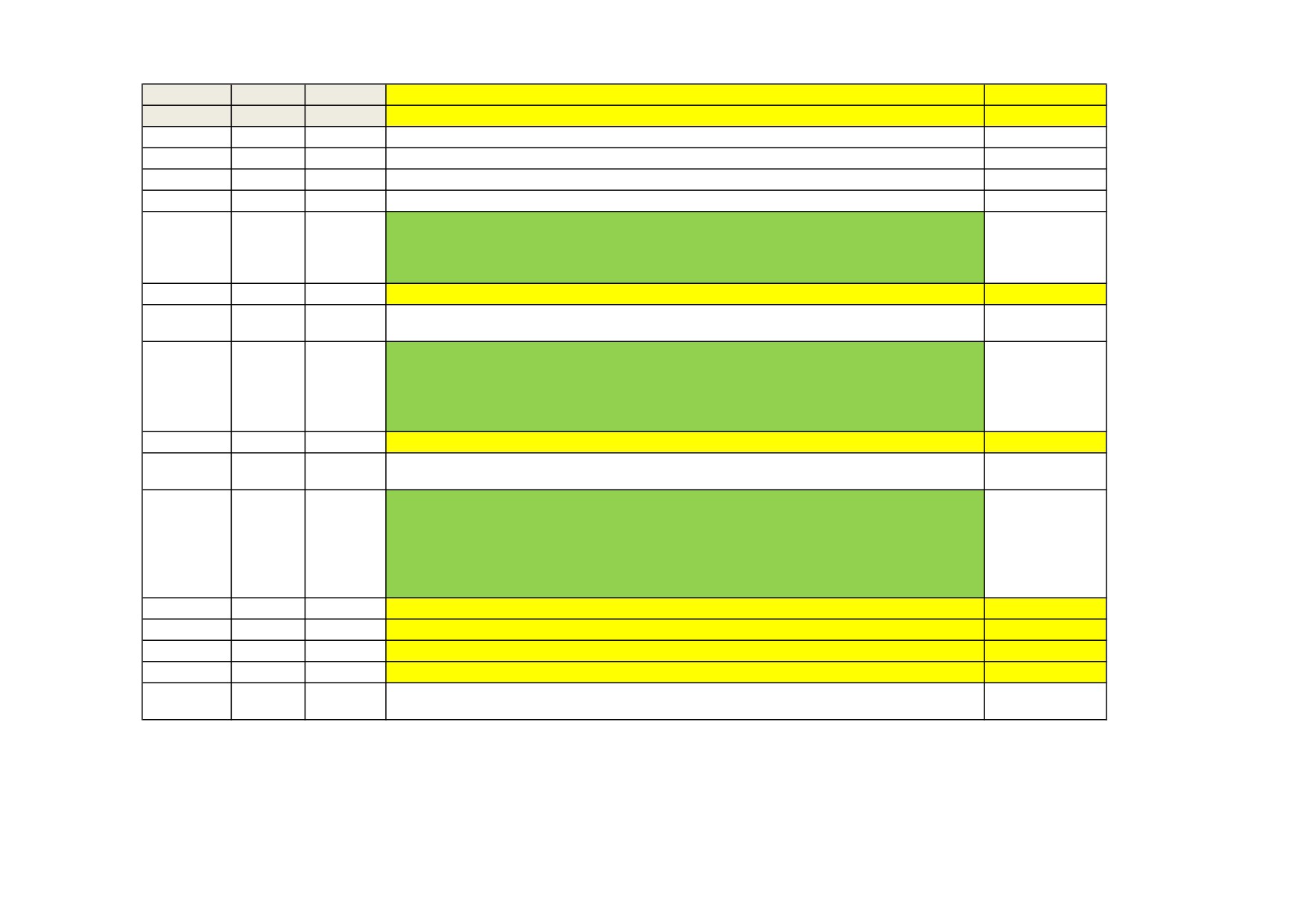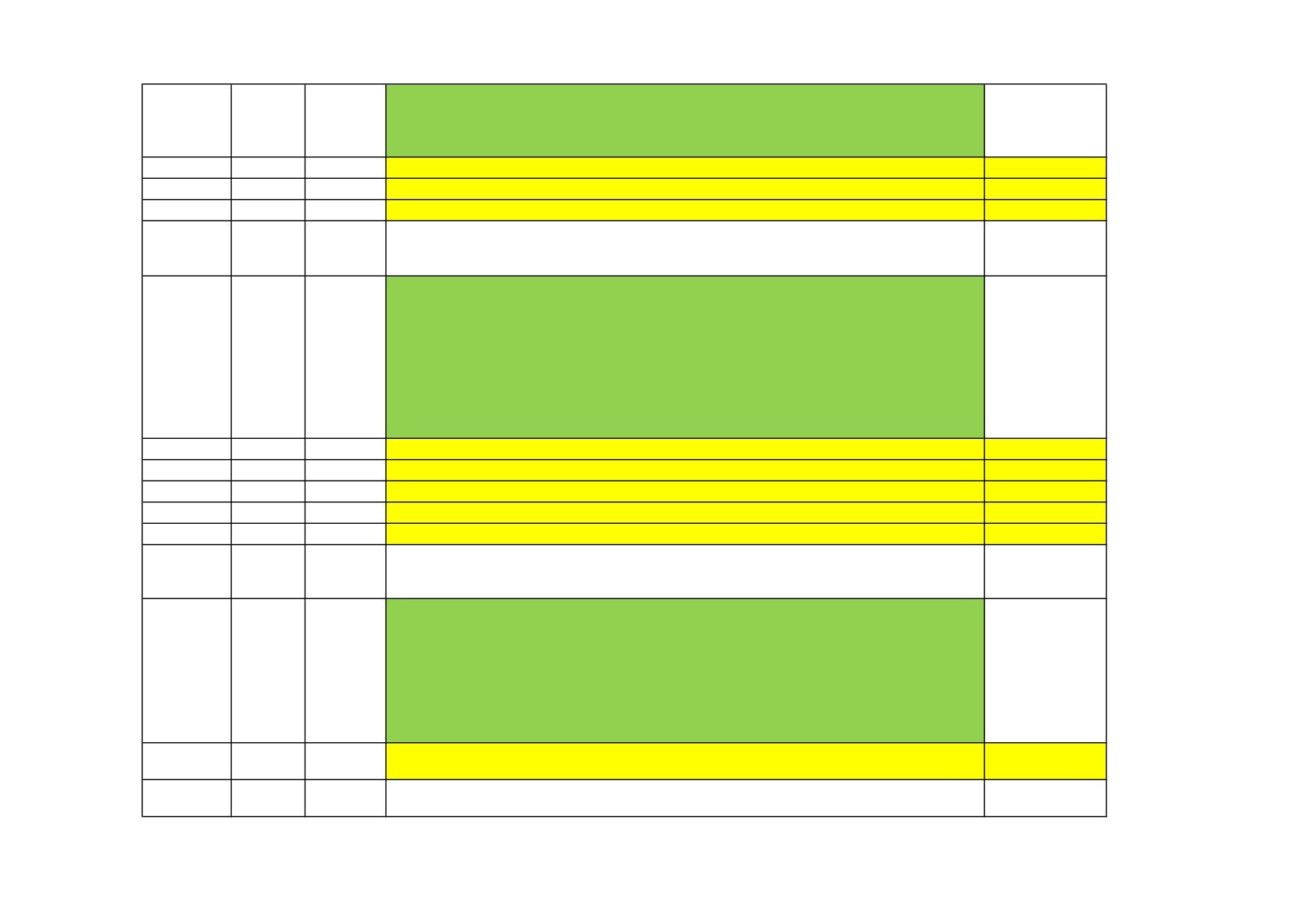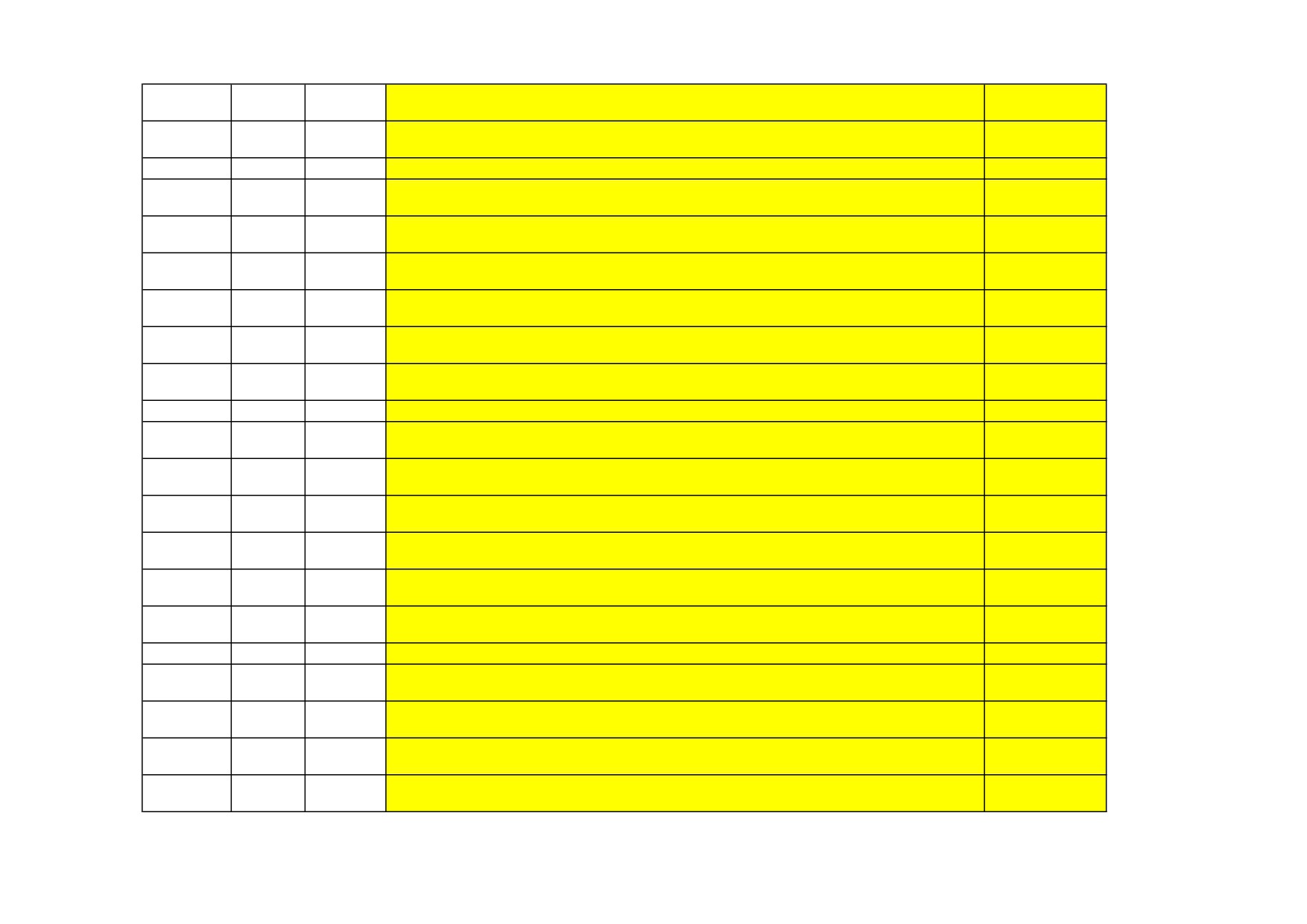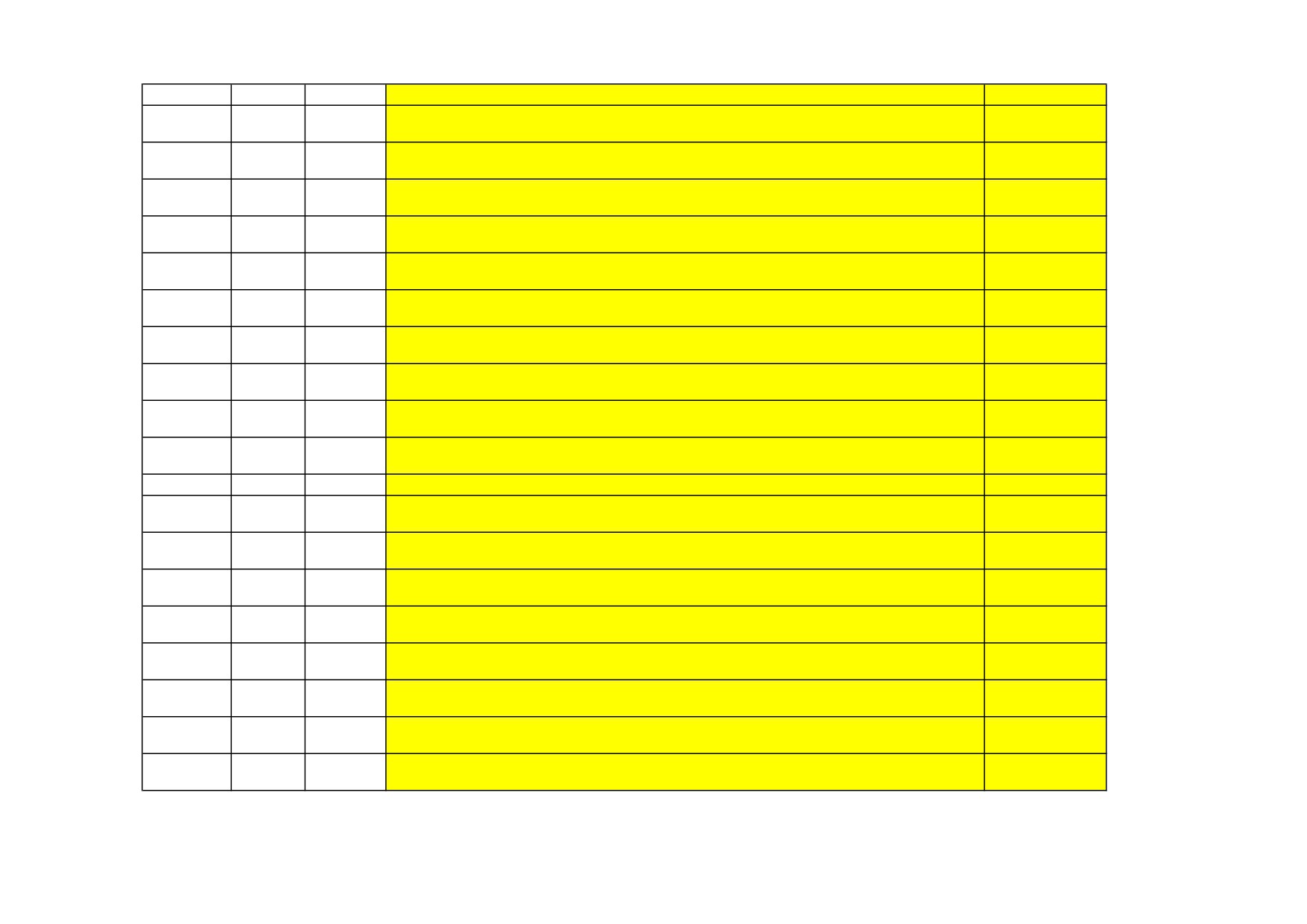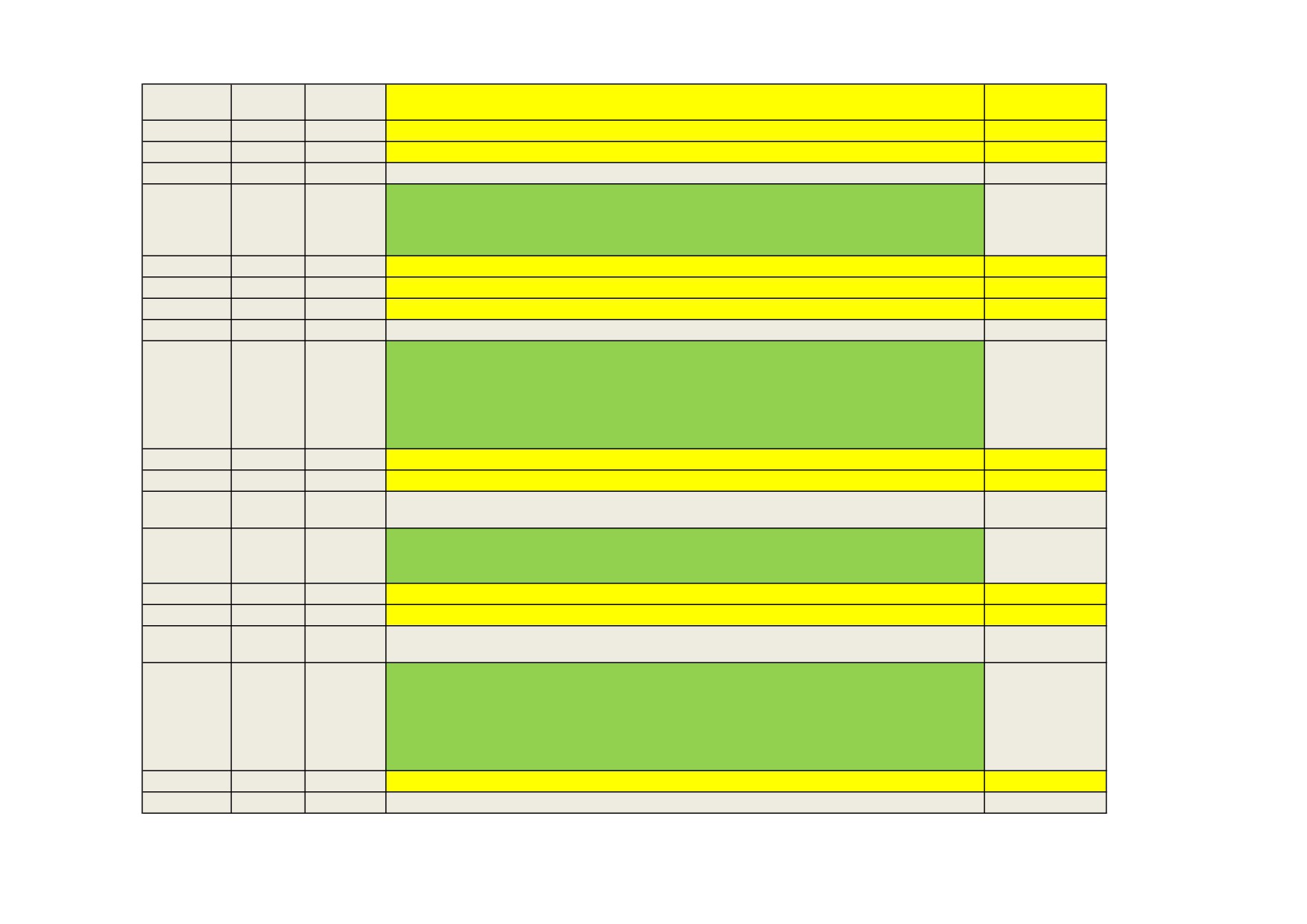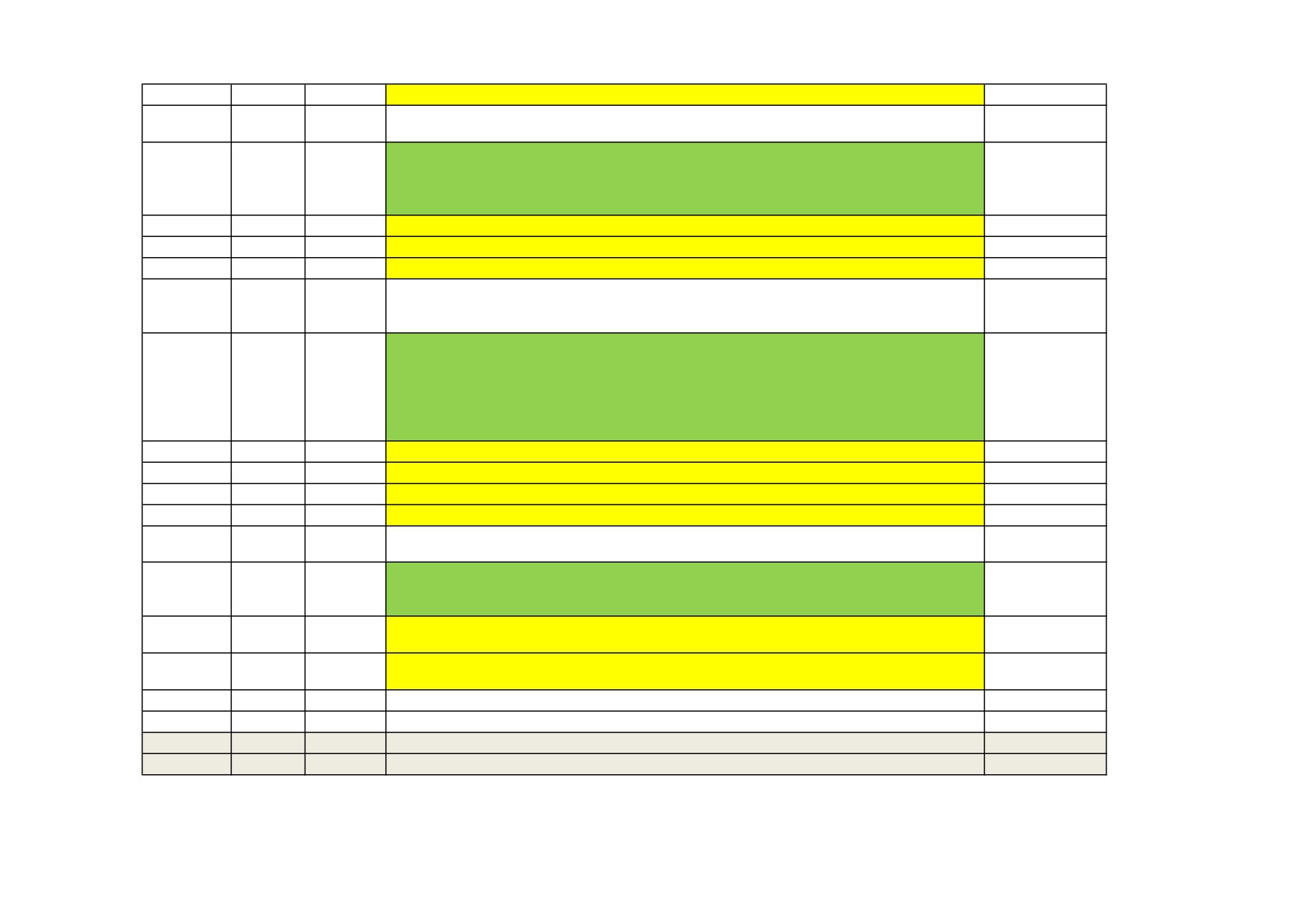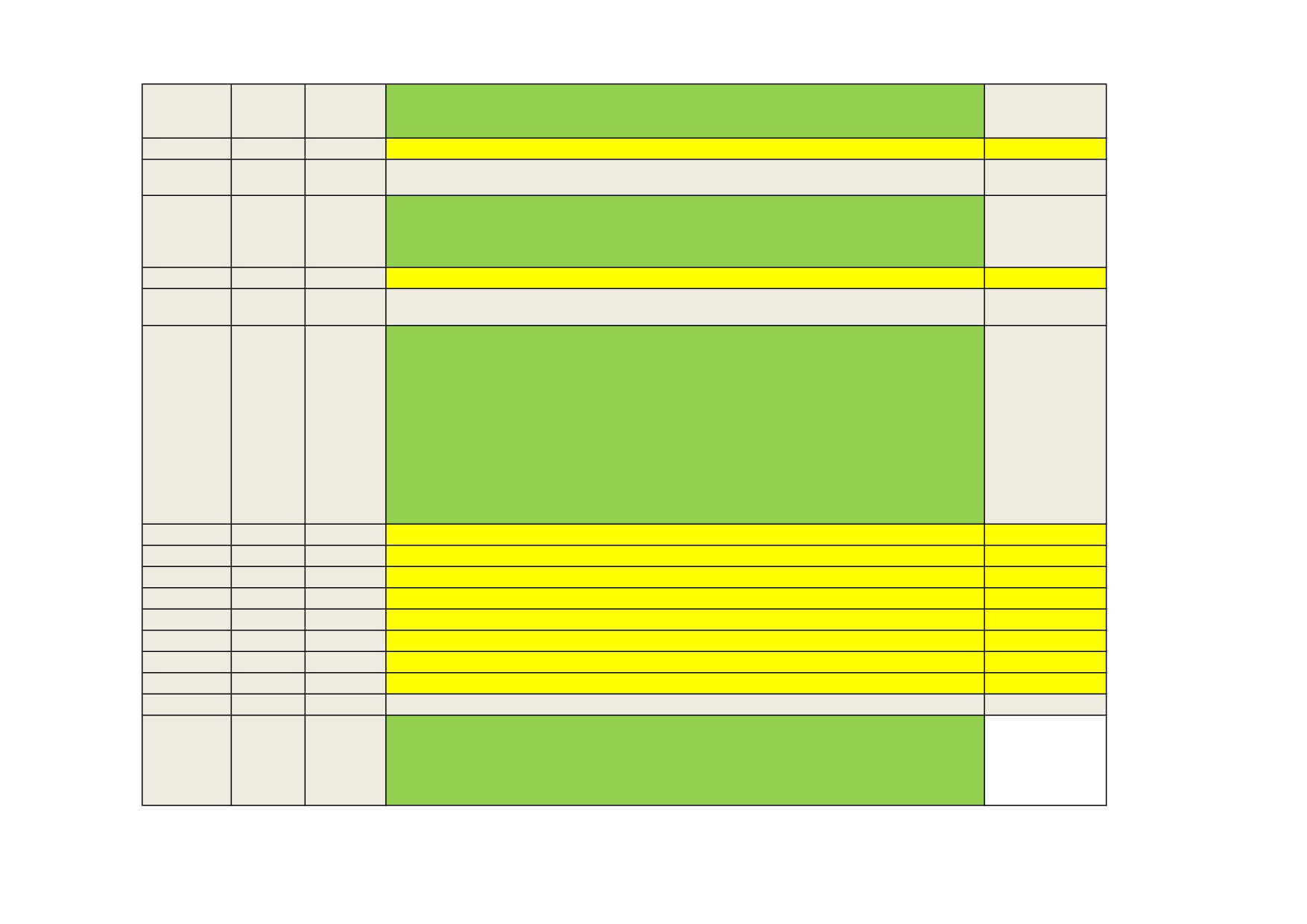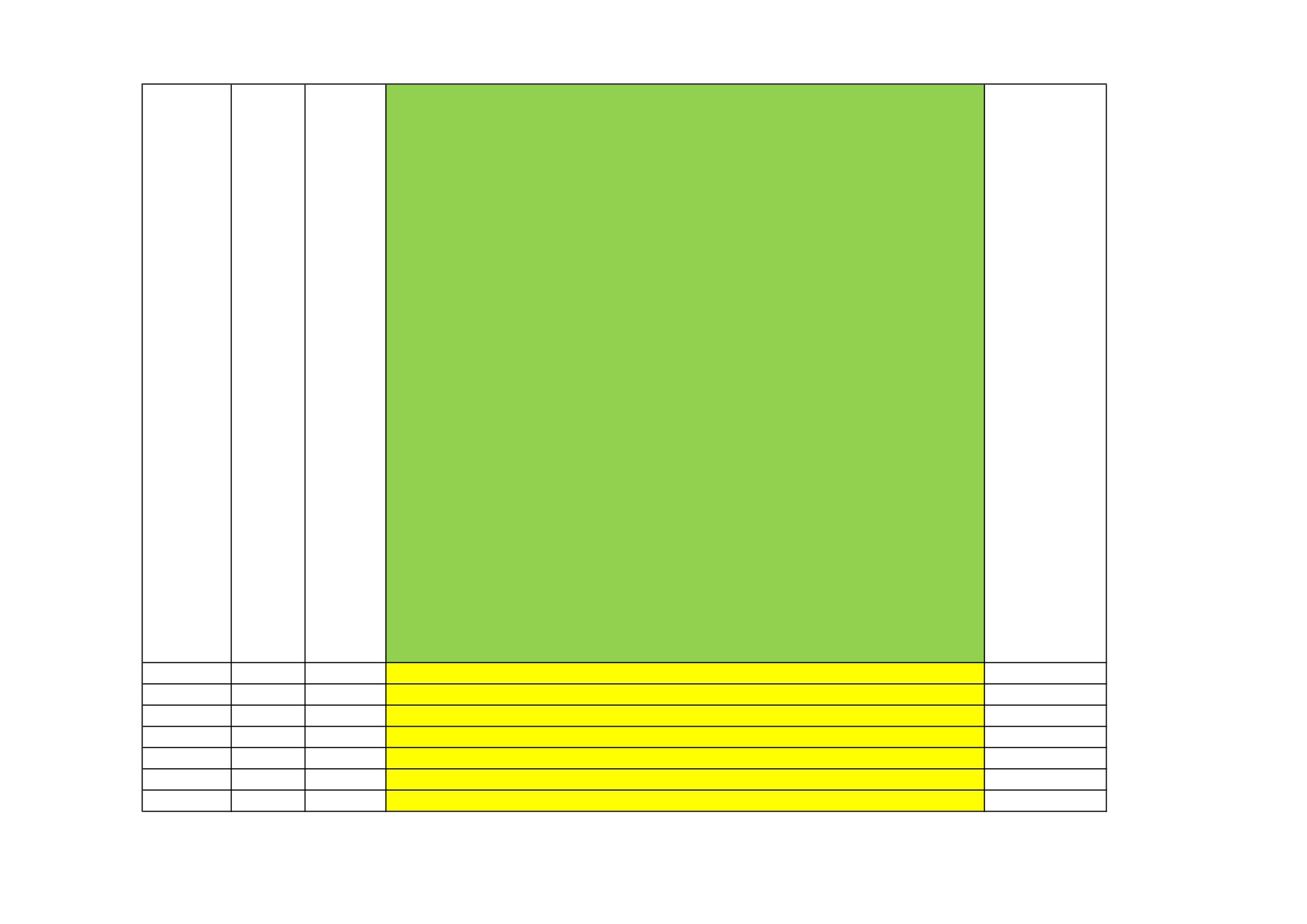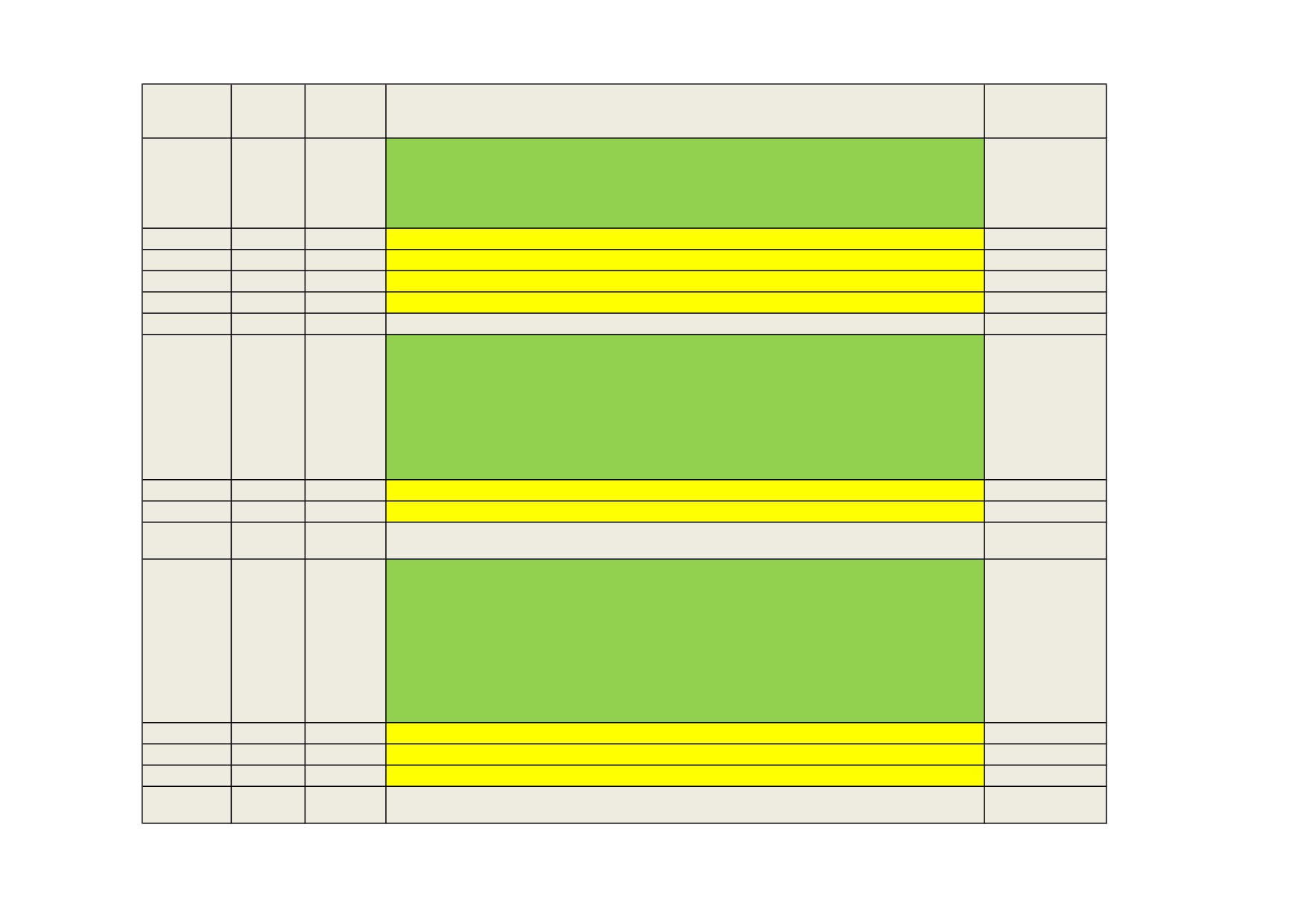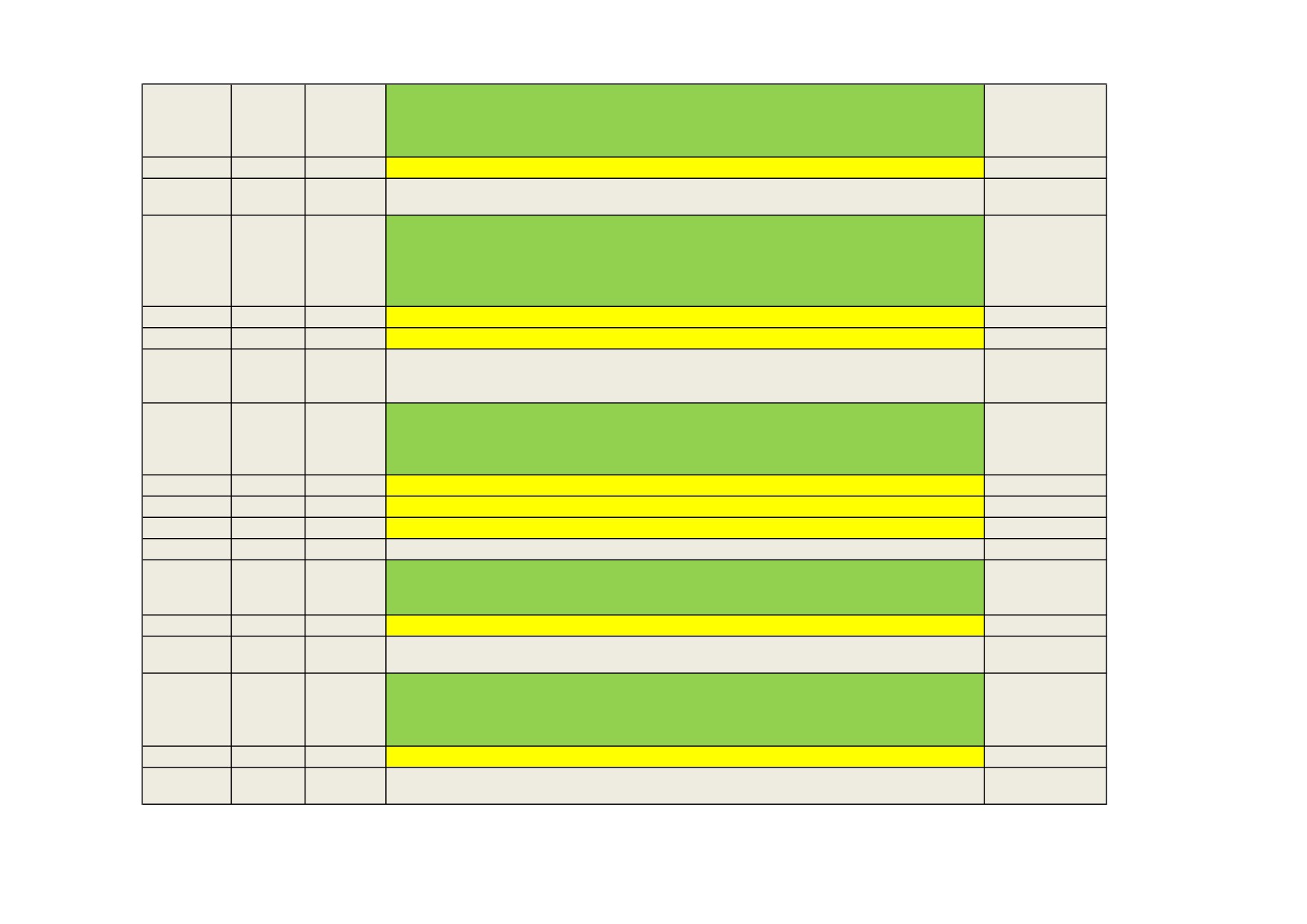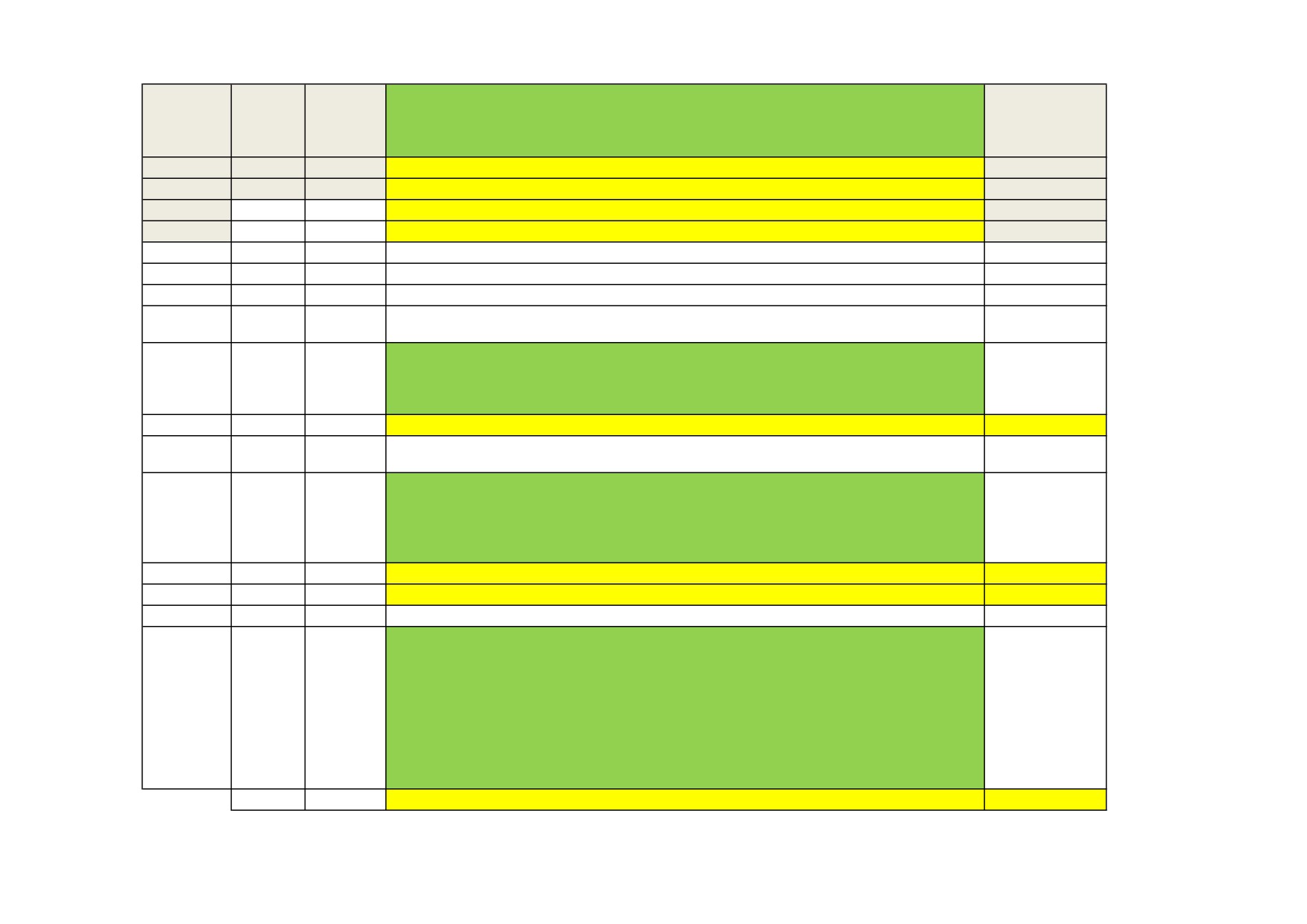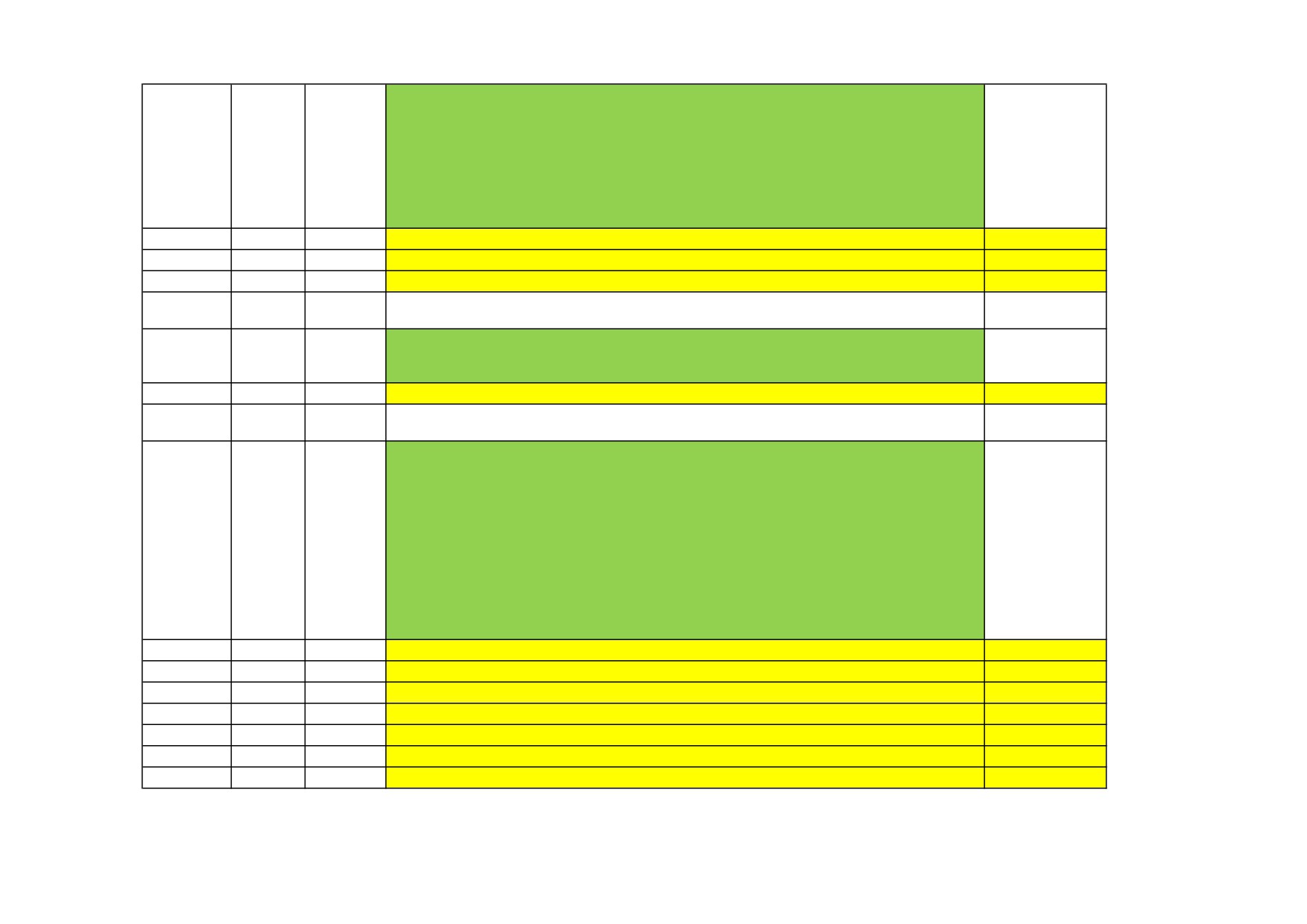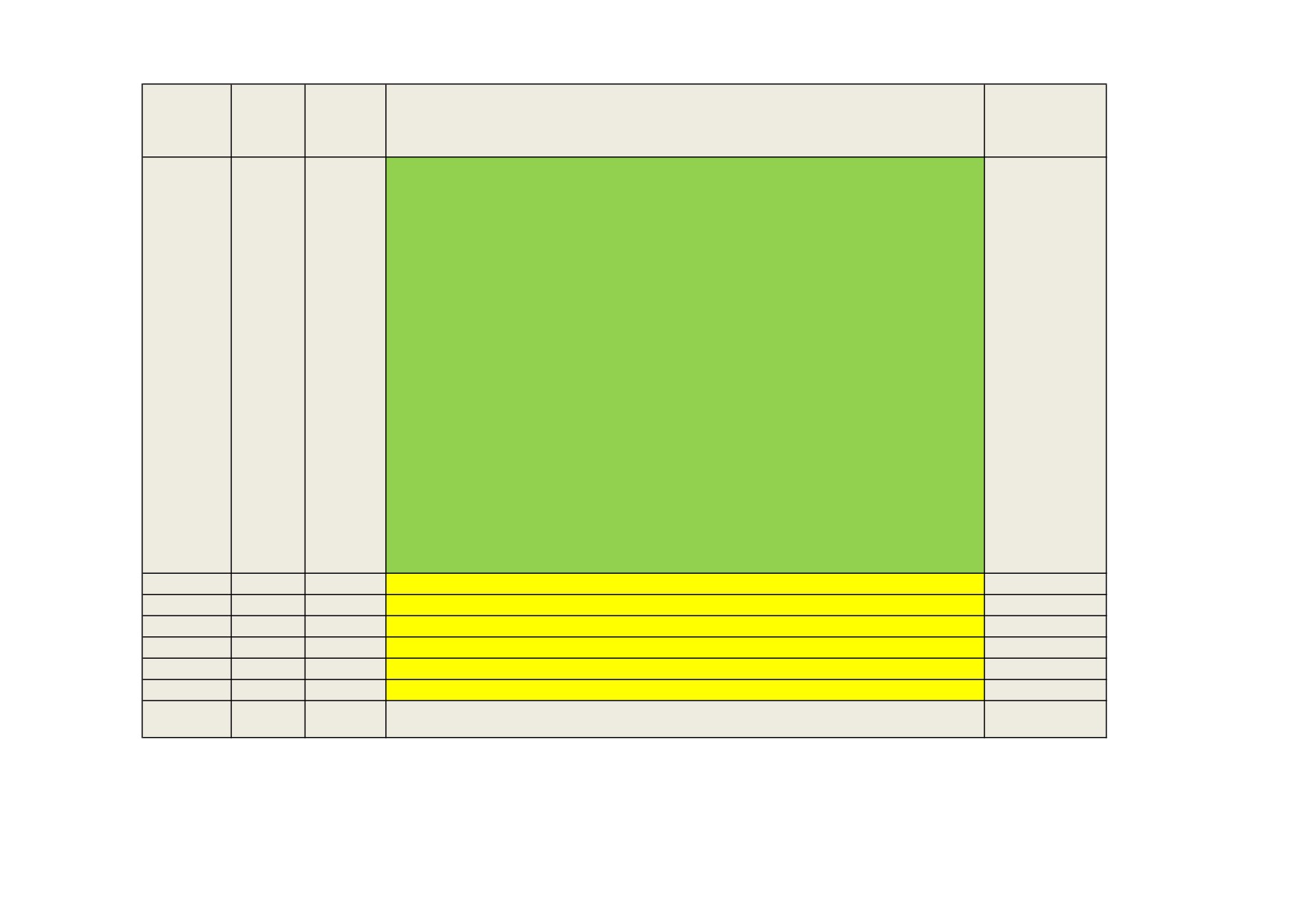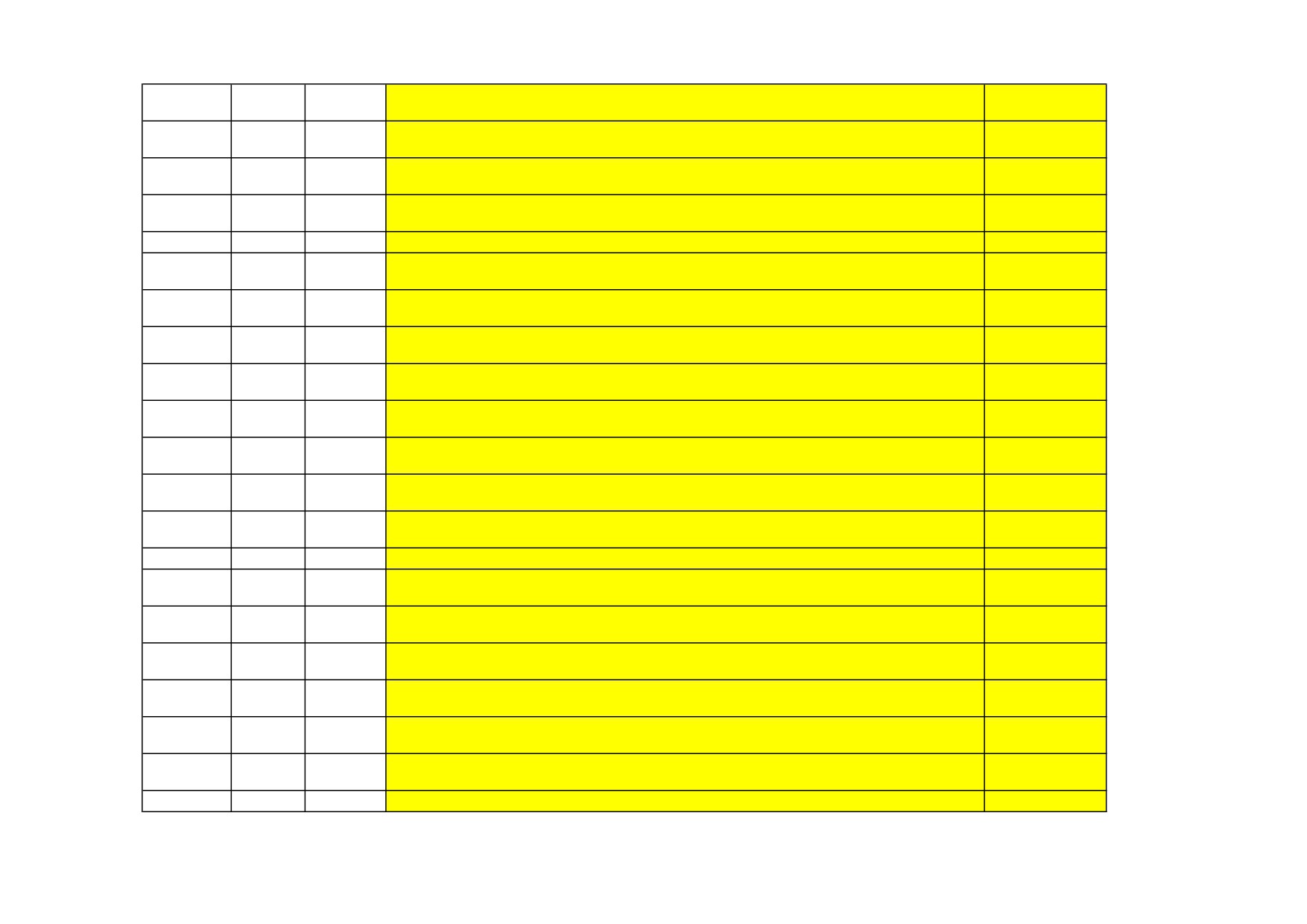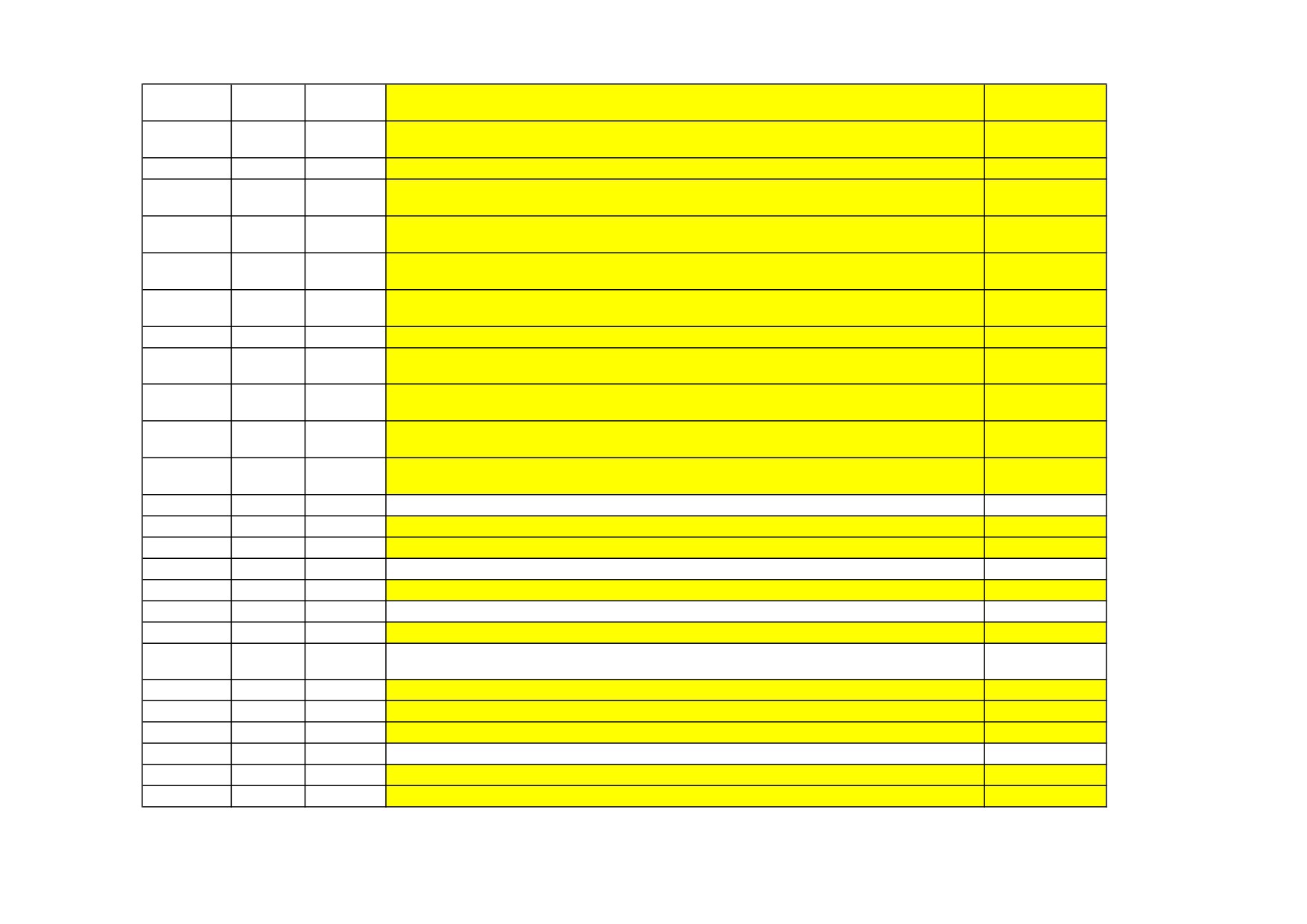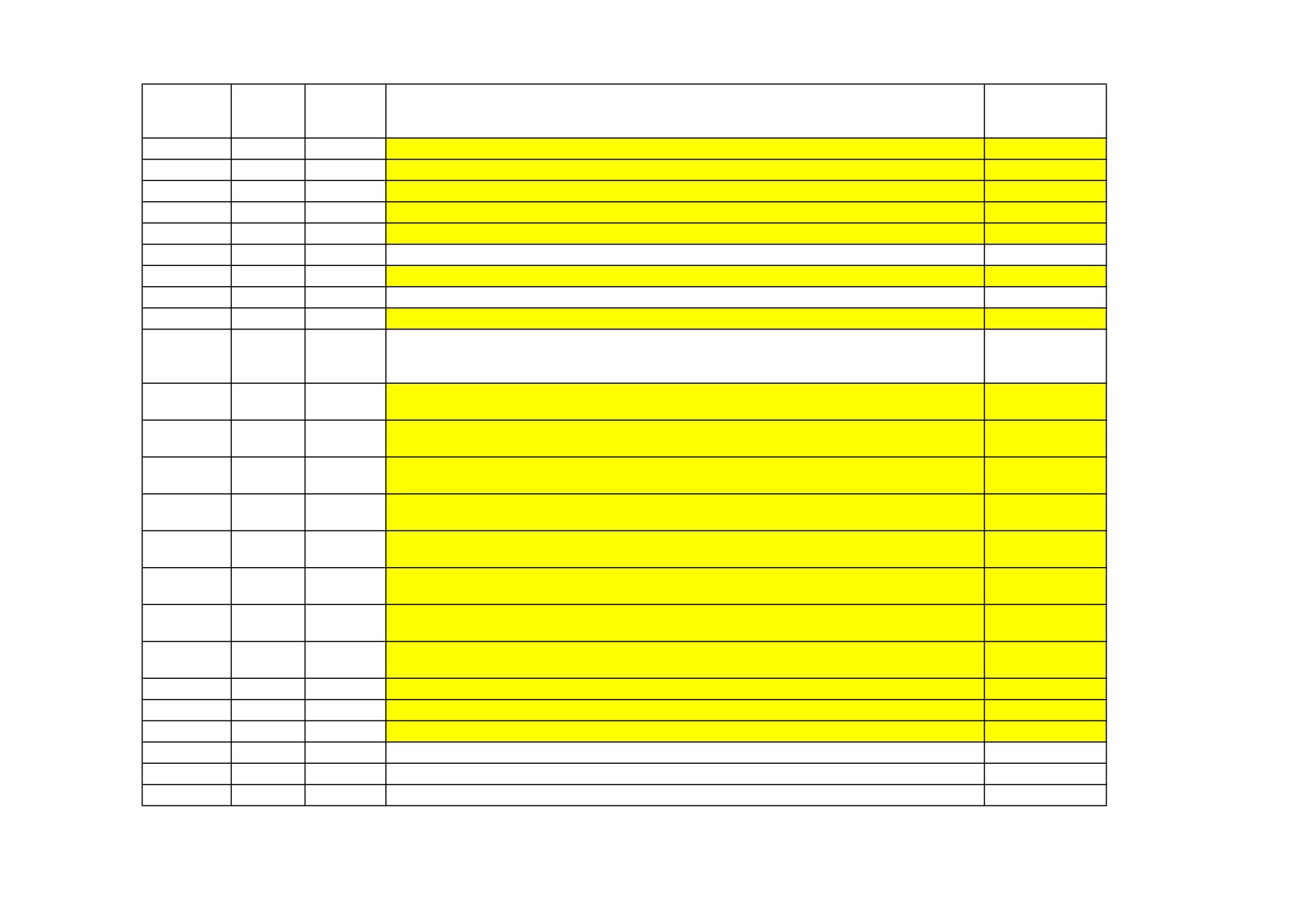AMCH Acad Pro
CBME UG Curricum for the IMR : Lesson Plan
Subject:Physiology
Topic: 11
Copmpetency/outomes: 137
Class Hours : 496
Teaching
Lecture No
Topic No
Comp. No pic: 11
Copmpetency/outomes: 137
Class Hours : 4
method
1
GENERAL PHYSIOLOGY
PY1.1
Describe the structure and functions of a mammalian cell
PY1.1/SLO
1.Describe the structure and functions of organelles in a cell
2. Applied physiology
1
Cell physiology
Lecture
2
Cell physiology
SDL
PY1.2
Describe and discuss the principles of homeostasis
PY1.2/SLO
1.Define homeostasis.
2.Positive and negative feedback mechanism.
3
Homeostasis
Lecture
PY1.3
Describe intercellular communication
PY1.3/SLO
1.Describe the types of intercellular communication.
2.Describe the mode of action of chemical messengers.
4
Intercellular communication
Lecture
PY1.4
Describe apoptosis - programmed cell death
PY1.4/SLO
1.Define apoptosis.
2Describe the mechanism of apoptosis and its physiological significance.
5
Apoptosis
SDL
PY1.5
Describe and discuss transport mechanisms across cell
PY1.5/SLO
Describe the active and passive transpot mechanisms across the cell membranes.
6
Active transport
Lecture
7
Passive transport
Lecture
8
Transport
SGD
9
Transport
SGD
10
Chart calculation, case histories discussion
SGD
PY1.6
Describe the fluid compartments of the body, its ionic
PY1.6/SLO
1.Describe the body fluid compartments of the body, ionic composition and
measurement
11
Lecture
1.Describe the body fluid compartments of the body, ionic composition and measurement
12
Charts, calculation, case histories discussion
SGD
PY1.7
Describe the concept of pH and Buffer systems in the body
PY1.7/SLO
1.Define pH.
2.Describe the role of the body fluid buffers in the maintenance
of pH
13
pH and buffer systems
Lecture
14
Henderson - Hassebach's equation
SGD
15
Henderson - Hassebach's equation
SGD
Describe and discuss the molecular basis of resting membrane
PY 1.8
potential and action potential in excitable tissue
PY1.8/SLO
1.Discuss the genesis of resting membrane potential
2.Explain Gibbs Donan equilibrium
3.Derive Nernst equation for sodium , potassium and chloride
4.Derive Goldman-Hodgkin-Katz equationObjectives:
5 To draw the action potential of a neuron, skeletal and smooth muscle and cardiac
muscle and describe the phases of action potential.
6.Describe its ionic basis and its uses in medicine
16
Resting Membrane Potential
Lecture
17
AP in neuron, skeletal and smooth muscle and cardiac muscle
Lecture
18
Applied Physiology of RMP and Action potential
SDL
Demonstrate the ability to describe and discuss the
PY1.9
methods used to demonstrate the functions of the cell and its
and its care and research
PY1.9/SLO
1.To explain the patch clamp techniques
19
Patch clamp technique
SGD
20
Patch clamp technique
SGD
2
HAEMATOLOGY
PY2.1
Describe the composition and functions of blood components
PY2.1/SLO
1. Describe the composition of blood
2. Discuss the functions of various blood components
21
Composition and functions of blood components
Lecture
PY2.2
Discuss the origin, forms, variations and functions of plasma
proteins
PY2.2/SLO
1. Discuss the origin and the various forms plasma proteins
2. Describe the Starling’s forces
3. Discuss the various functions of plasma proteins
4. Applied physiology: Kwashiorkar, Edema
22
Plasma proteins
Lecture
PY2.3
Describe and discuss the synthesis and functions of Haemoglobin and explain its
breakdown. Describe variants of haemoglobin
PY2.3/SLO
1. Describe the synthesis and functions of of Hb
2. Disuss the fate of RBC
3. Explain the various types of complexes of Hb
4. Describe various hemoglobinopathies
5. Applied physiology - cyanosis
23
Haemoglobin
Lecture
24
Hemoglobin and its physiological relevance
SGD
25
Hemoglobin and its physiological relevance
SGD
26
Charts, calculation, case histories discussion
SGD
Describe RBC formation (erythropoiesis and its regulation) and its
PY2.4
functions
PY2.4/SLO
1. Define erythropoiesis
2. Explain various theories of erythropoiesis
3. Mention the various sites of erythropoiesis
4. Describe the stages of erythropoiesis and the regulation of erythropoiesis
5. Discuss various functions of RBC
27
RBC
Lecture
PY2.5
Describe different types of anaemias and Jaundice
PY2.5/SLO
1. Define anaemia
2. Etiological and morphological classification of anaemia
3. Describe the effects, symptoms, signs and principles of treatment of anaemia
4. Define and classify polycytemia
5. Describe the effects, symptoms, signs and principle of treatment of polycythemia
6. Calculate the RBC indices and interpret the values
28
Anaemia
Lecture
29
Jaundice
SGD
30
Jaundice
SGD
31
Anaemia
IT
32
Anaemia
IT
33
RBC indices
SDL
PY2.6
Describe WBC formation (granulopoiesis) and its regulation
PY2.6/SLO
1.Classify WBCs
2.Describe the morphology of Granlocytes and Agranulocytes
3.Discuss various stages, development and regulation of WBC
4.Explain the steps involved in phagocytosis
5.Mention the normal count of WBC and its variations
34
WBC
Lecture
35
Phagocytosis
SGD
36
Phagocytosis
SGD
37
Charts, calculation, case histories discussion
SGD
PY2.7
Describe the formation of platelets, functions and variations
PY2.7/SLO
1.Describe the formation, structure, life span and fate of platelets
2.Mention the normal platelet count and its variation
3.Disuss the various functions of platelets
38
Platelets
Lecture
39
Bleeding disorders
SGD
40
Bleeding disorders
SGD
PY2.8
Describe the physiological basis of hemostasis and,
anticoagulants. Describe bleeding and clotting disorders (Hemophilia, purpura)
PY2.8/SLO
1.Define hemostasis
2.Describe the process involved in hemostasis
3.Explain the coagulation pathways
4. Explain the anticlotting and fibrinolytic mechanisms in the body
5.Mention the anticoagulants (therapeutic and laboratory) and their mechanism of
action
6.Discuss the various causes for abnormal haemostasis
7.Descirbe the various tests for hemostasis
41
Hemostasis - I
Lecture
42
Hemostasis - II
Lecture
43
Hemophilia, purpura and dengue
SGD
44
Hemophilia, purpura and dengue
SGD
45
Clotting disorders
SDL
PY2.9
Describe different blood groups and discuss the clinical importance of blood grouping,
blood banking and transfusion
PY2.9/SLO
1.Define Landstainer’s Law
2.Explain various blood group systems: Major ,Minor
3.Describe the mechanisms and consequence of ABO and Rh in compatibility
(erythroblastosis foetalis)
4.Discuss in detail about blood transfusion
5.Describe the various hazards of blood transfusion
46
Blood groups
Lecture
PY2.10
Define and classify different types of immunity. Describe the
development of immunity and its regulation
PY2.10/SLO
1.Define and classify immunity
2.Discuss the development of T and B cells
3.Explain the mechanism of cell mediated immunity
4.Explain the mechanism of humoral immunity
5. Describe the structure, functions of different types of immunoglobulins
6. Descibe in detail the complement system
7. Discuss transplant rejection,hypersensitivity,immune-deficiency
8. Explain about immunological tolerance, autoimmunity
immune modulation and immunodeficiency diseases
47
Immunity - I
Lecture
48
Lymph and Reticuloendothelial system
SDL
49
Immunity - II
Lecture
50
Immunity - III
Lecture
PY2.11
Estimate Hb, RBC, TLC, RBC indices, DLC, Blood groups, BT/CT
PY2.11/SLO
1.Estimate hemoglobin and intrepret the values
2.Determine the RBC count and intrepret the values
3.Determine the TLC count and intrepret the values
4.Calculate the RBC indices and intrepret the values
5.Determine the DLC count and intrepret the values
6.Identify the blood group
7.Determine the BT/CT and intrepret the values
51
Practical briefing on Hb estimation
SGD
DOAP
52
Estimation of Hb
session
DOAP
53
Estimation of Hb
session
DOAP
54
Estimation of Hb
session
DOAP
55
Estimation of Hb
session
DOAP
56
Estimation of Hb
session
DOAP
57
Estimation of Hb
session
58
Practical briefing on compound microscope
SGD
59
Practical briefing on Improved Neubeaur's chamber
SGD
DOAP
60
Compound microscope Improved Neubeaur's chamber
session
DOAP
61
Compound microscope, Improved Neubeaur's chamber
session
62
Practical briefing on determination of RBC count
SGD
DOAP
63
Determination of RBC count
session
DOAP
64
Determination of RBC count
session
DOAP
65
Determination of RBC count
session
DOAP
66
Determination of RBC count
session
DOAP
67
Determination of RBC count
session
DOAP
68
Determination of RBC count
session
69
Practical briefing on determination of TLC count
SGD
DOAP
70
Determination of TLC count
session
DOAP
71
Determination of TLC count
session
DOAP
72
Determination of TLC count
session
DOAP
73
Determination of TLC count
session
DOAP
74
Determination of TLC count
session
DOAP
75
Determination of TLC count
session
76
Briefing on Calculation of RBC indices
SGD
DOAP
77
Calculation of RBC indices
session
DOAP
78
Calculation of RBC indices
session
DOAP
79
Calculation of RBC indices
session
DOAP
80
Calculation of RBC indices
session
81
Practical briefing on determination of DLC count
SGD
DOAP
82
Determination of DLC count - Preparation of ideal smear
session
DOAP
83
Determination of DLC count - Preparation of ideal smear
session
DOAP
84
Determination of DLC count - Preparation of ideal smear
session
DOAP
85
Determination of DLC count - Preparation of ideal smear
session
DOAP
86
Determination of DLC count
session
DOAP
87
Determination of DLC count
session
DOAP
88
Determination of DLC count
session
DOAP
89
Determination of DLC count
session
DOAP
90
Determination of DLC count
session
DOAP
91
Determination of DLC count
session
92
Practical briefing on blood groups,bleeding time, clotting time
SGD
DOAP
93
Determination of blood groups
session
DOAP
94
Determination of blood groups
session
DOAP
95
Determination of blood groups
session
DOAP
96
Determination of blood groups
session
DOAP
97
Determination of blood groups
session
DOAP
98
Determination of blood groups
session
DOAP
99
Determination of bleeding time, clotting time
session
DOAP
100
Determination of bleeding time, clotting time
session
DOAP
101
Determination of bleeding time, clotting time
session
DOAP
102
Determination of bleeding time, clotting time
session
DOAP
103
Determination of bleeding time, clotting time
session
DOAP
104
Determination of bleeding time, clotting time
session
Describe test for ESR, Osmotic fragility, Hematocrit.
PY2.12
Note the findings and interpret the test results etc
PY2.12/SLO
1.Observe the procedure of ESR and intrepret the results
2.Observe the procedure of osmotic fragility and intrepret the results
3. Observe the procedure of hematocrit and intrepret the results
105
Practical briefing on ESR and Hematocrit
SGD
106
Practical briefing on osmotic fragility & specific gravity
SGD
107
ESR, Osmotic fragility and Hematocrit
Demonstration
108
ESR, Osmotic fragility and Hematocrit
Demonstration
109
ESR, Osmotic fragility and Hematocrit
Demonstration
110
ESR, Osmotic fragility and Hematocrit
Demonstration
PY2.13
Describe steps for reticulocyte and platelet count
PY2.13/SLO
1.Observe the procedure of counting the reticulocytes and interpret the values
2..Observe the procedure of counting the platelets and interpret the values
111
Practical briefing on reticulocyte and platelet count
SGD
112
Reticulocyte and platelet count
Demonstration
113
Reticulocyte and platelet count
Demonstration
114
Briefing on OSPE
SGD
3
NERVE and MUSCLE PHYSIOLOGY
Describe the structure and functions of a neuron and neuroglia;
PY3.1
Discuss Nerve Growth Factor and other growth factors/cytokines
PY3.1/SLO
1.Describe the structure and functions of neuron.
2.Describe the types of neuroglia and their functions
3. Discuss the functions of nerve growth factors, growth factors and cytokines
115
Neuron
SDL
116
Nerve growth factor, growth factors and cytokines
SGD
117
Nerve growth factor, growth factors and cytokines
SGD
PY3.2
Describe the types, functions and properties of nerve fibers
PY 3.2/SLO
1. Discuss types of fibers
2. Describe the properties of nerve fibers
3.Describe myelination in CNS and PNS
4.Discuss saltatory conduction
5.Classification of nerve injuries
118
Classification of nerve fibers
SDL
Properties of nerve fibers, myelination in CNS and PNS, saltatory conduction.Applied
119
physiology,
Lecture
PY3.3
Describe the degeneration and regeneration in peripheral nerves
PY 3.3/SLO
1.Classification of nerve injuries
2.Discuss Wallaerian degenerative changes in the neuron
3.Discuss regenerative changes in the neuron
120
Wallerian degeneration and regeneration of nerves
Lecture
PY3.4
Describe the structure of neuro-muscular junction and
transmission of impulses
PY 3.4/SLO
1.Describe structure of neuro muscular junction.
2.Discuss the events neuro musculartransmission.
121
Structure of neuro muscular junction.neuro musculartransmission.
Lecture
PY3.5
Discuss the action of neuro-muscular blocking agents
PY3.5/SLO
1.Discuss the drugs acting on neuro muscular junction.---blockers, stimulators.
Drugs acting on neuro muscular junctionblockers,
Lecture
122
stimulators.
123
Neuro muscular junction and blocking agents and stimulators
IT
124
Neuro muscular junction and blocking agents and stimulators
IT
PY3.6
Describe the pathophysiology of Myasthenia gravis
PY 3.6/SLO
1.Discuss neuromuscular disorders.
2.Discuss myasthenia gravis,symptoms ,signs and physiological basis of treatment.
125
Chart, case history discussion
SGD
126
Myasthenia gravis
SGD
127
Myasthenia gravis
SGD
PY3.7
Describe the different types of muscle fibres and their structure
PY 3.7/SLO
1. Discuss the difference between skeletal, cardiac and smooth muscle
2.Describe the types of muscle,structure of muscle fibre,myofibril,sarcomere,actin and
myosin,sarcotubular system,
128
Difference between skeletal, cardiac and smooth muscle
Lecture
129
Structure of skeletal muscle, sarcotubular system
Lecture
PY3.8
Describe action potential and its properties in different muscle types
(skeletal and smooth)
PY 3.8/SLO
1. Action potential and ionic basis.
2. Describe the properties of skeletal and smooth muscle.
130
AP in neuron, skeletal and smooth muscle , ionic basis.
Lecture
131
Describe the properties of skeletal and smooth muscle
Lecture
PY3.9
Describe the molecular basis of muscle contraction in skeletal and in smooth muscles
PY3.9/SLO
1. Discuss molecular basis of skeletal muscle contraction.
2. Discuss the process of excitation- contraction
3.Discuss sliding filament theory
4.Discuss the types of contraction
132
Excitation contraction coupling
Lecture
PY3.10
Describe the mode of muscle contraction (isometric and isotonic)
PY3.10/SLO
1. Discuss Isotonic and isometric contraction
133
Types of muscle contraction
SGD
134
Types of muscle contraction
SGD
PY3.11
Explain energy source and muscle metabolism
PY 3.11/SLO
1.Discuss the metabolism in muscle
2.Discuss the source of energy for skeletal muscle contraction .
135
Metabolism in Skeletal muscle
SGD
136
Metabolism in Skeletal muscle
SGD
PY3.12
Explain the gradation of muscular activity
PY3.12/SLO
1.Explain gradation of mild ,moderate and severe activity in skeletal muscle.
137
Muscular gradation
SGD
138
Muscular gradation
SGD
PY3.13
Describe muscular dystrophy: myopathies
PY3.13/SLO
1.Explain the physiological basis of Beckers dystrophy,
2.Explain the physiological basis of Eaton-lambert syndrome
139
Neuromuscular disorders.Beckers dystrophy,Eaton-lambert syndrome
SGD
140
Neuromuscular disorders.Beckers dystrophy,Eaton-lambert syndrome
SGD
PY3.14
Perform Ergography
PY3.14/SLO
1.Record and calculate the work done using mossos ergograph.
2.Discuss and study the effect of arterial occulsion and discuss the physiological basis.
3.Discuss and study the effect of Venous occulsion and discuss the physiological basis
4. Discuss and study the effect of motivation and discuss the physiological basis
141
Practical briefing on ergography
SGD
DOAP
142
Ergograph
session
DOAP
143
Ergograph
session
Demonstrate effect of mild, moderate and severe exercise and
PY3.15
record changes in cardiorespiratory parameters
PY 3.15/SLO
1. Discuss the effect of mild, moderate and severe exercise and
record changes in cardiorespiratory parameters
144
Practical briefing on effect of exercise on CVS
SGD
145
Practical briefing on effect of exercise on RS
SGD
Demonstrate effect of mild, moderate and severe exercise and
DOAP
146
record changes in cardiorespiratory parameters
session
Demonstrate effect of mild, moderate and severe exercise and
DOAP
147
record changes in cardiorespiratory parameters
session
Demonstrate effect of mild, moderate and severe exercise and
DOAP
148
record changes in cardiorespiratory parameters- Revision
session
Demonstrate effect of mild, moderate and severe exercise and
DOAP
149
record changes in cardiorespiratory parameters-Revision
session
Demonstrate effect of mild, moderate and severe exercise and
DOAP
150
record changes in cardiorespiratory parameters-Revision
session
Demonstrate effect of mild, moderate and severe exercise and
DOAP
151
record changes in cardiorespiratory parameters-Revision
session
Demonstrate Harvard Step test and describe the impact on
PY3.16
induced physiologic parameters in a simulated environment
PY3.16/SLO
1.Demonstrate Harvard Step test
2.Describe the impact on heart rate and blood pressure in a simulated environment
DOAP
Demonstrate Harvard Step test and describe the impact on
152
induced physiologic parameters in a simulated environment
session
Demonstrate Harvard Step test and describe the impact on
DOAP
153
induced physiologic parameters in a simulated environment
session
PY3.17
Describe Strength-duration curve
PY3.17/SLO
1.Chronaxie
2.Rheobase
154
Chart, case history discussion
SGD
155
Strength duration curve
SGD
156
Strength duration curve
SGD
Observe with Computer assisted learning (i) amphibian nerve -
PY3.18
muscle experiments (ii) amphibian cardiac experiments
PY3.18/SLO
1. Discuss the amphibian nerve muscle contraction with Computer assisted learning
2.Discuss the amphibian properties of cardiac muscle with Computer assisted learning
Observe with Computer assisted learning (i) amphibian nerve -
157
CALM
muscle experiments (ii) amphibian cardiac experiments
Observe with Computer assisted learning (i) amphibian nerve -
158
CALM
muscle experiments (ii) amphibian cardiac experiments
4
GASTROINTESTINAL PHYSIOLOGY
PY4.1
Describe the structure and functions of digestive system
PY4.1/SLO
1. Describe the structural anatomy of digestive system
2. Discuss the functions of digestive system
159
Structural anatomy and functions of digestive system
SDL
Describe the composition, mechanism of secretion, functions,
PY4.2
and regulation of saliva, gastric, pancreatic, intestinal juices and bile secretion
PY4.2/SLO
1.Describe the composition, mechanism of secretion, functions,
and regulation of salivary secretion
2.Describe the composition, mechanism of secretion, functions,
and regulation of gastric secretion
3.Describe the composition, mechanism of secretion, functions,
and regulation of pancreatic secretion
4.Describe the composition, mechanism of secretion, functions,
and regulation of intestinal secretion
5.Describe the composition, mechanism of secretion, functions,
and regulation of bile secretion
160
Salivary secretion
Lecture
161
Gastric secretion
Lecture
162
Charts and case histories discussion
SGD
163
Pancreatic secretion
Lecture
164
Intestinal juices
Lecture
165
Bile secretion
Lecture
166
Jaundice
SDL
Describe GIT movements, regulation and functions. Describe defecation reflex. Explain
PY4.3
role of dietary fibre.
PY4.3/SLO
1.Describe swallowing and peristalsis.
2.Describe small intestinal and large intestinal movements
3.Discuss the regulation and functions of various GIT movements
4.Mention the importance of dietary fiber
5.Describe defecation reflex
167
GIT movements, defecation reflex
Lecture
PY4.4
Describe the physiology of digestion and absorption of nutrients
PY4.4/SLO
1.Describe the digestion and absorption of carbohydrates
2.Describe the digestion and absorption of proteins
3.Describe the digestion and absorption of fats
168
Digestion and absorption of nutrients
Lecture
Describe the source of GIT hormones, their regulation and
PY4.5
functions
PY4.5/SLO
1.Describe the various source of GIT hormones
2.Describe the regulation and functions of GIT hormones
169
GIT hormones
SGD
170
GIT hormones
SGD
PY4.6
Describe the Gut-Brain Axis
PY4.6/SLO
1.Describe the enteric nervous system and autonomic nerve supply of the GIT
2.Explain the role of various neurotransmitters in GIT
3.Discuss the various gastro intestinal reflexes
171
Gut-Brain Axis / Enteric nervous system
Lecture
PY4.7
Describe and discuss the structure and functions of liver and gall bladder
PY4.7/SLO
1.Describe the physiological anatomy of liver and gall bladder
2.Describe the functions of liver and gall bladder
3.Disuss the various applied aspects of liver and gall bladder
172
Liver and gall bladder
Lecture
Describe and discuss gastric function tests, pancreatic exocrine function tests and
PY4.8
liver function tests
PY4.8/SLO
1.Describe and discuss the gastric function tests
2.Describe and discuss the exocrine pancreatic function tests 3.Describe and discuss
the liver function tests
173
Gastric tests, pancreatic exocrine liver function tests
Lecture
174
Gastric and exocrine pancreatic function test
SGD
175
Liver function test
SGD
Discuss the physiology aspects of: peptic ulcer, gastro- oesophageal reflux disease,
vomiting, diarrhoea, constipation, Adynamic ileus, Hirschsprung's disease
PY4.9
PY4.9/SLO
1.Discuss the physiological aspects of peptic ulcer
2.Discuss the physiological aspects of gastro- oesophageal reflux disease
3.Discuss the physiological aspects of vomiting and diarrhoea
4.Discuss the physiological aspects of constipation, adynamic ileus and
Hirschsprung's disease
176
GIT - Applied physiology
Lecture
177
Charts and case histories discussion
SGD
178
Peptic ulcer,Gastro - oesophageal reflux disease
IT
179
Peptic ulcer,Gastro - oesophageal reflux disease
IT
Demonstrate the correct clinical examination of the abdomen in a normal volunteer or
PY4.10
simulated environment
PY4.10/SLO
1.Demonstrate the clinical examination of the abdomen in a normal volunteer
DOAP
180
Clinical examination of abdomen
session
DOAP
181
Clinical examination of abdomen
session
5
Renal Physiology
PY7.1
Describe structure and function of kidney
PY7.1/SLO
1. Discuss the physiological role kidney in homeostasis.
182
Introduction to Kidney
Lecture
Describe the structure and functions of juxta glomerular apparatus and role of renin-
PY7.2
angiotensin system
PY7.2/SLO
1.Describe the structrure of juxta glomerular apparatus
2.Discuss the functions of juxta glomerular apparatus
183
Juxta glomerular apparatus
Lecture
PY7.3
Describe the mechanism of urine formation involving processes of filtration, tubular
reabsorption and secretion; concentration and diluting mechanism
PY7.3/SLO
1.Define GFR.
2.Discuss the factors affecting GFR.
3.Explain the calacualtion of GFR.
4.Discuss Tubular reabsorption in kidney.
5. DiscussTubular secretion in kidney.
6. Discuss functioning of DCT.
7. Discuss the renal handling of different solutes.
8.Explain concentration and dilution of urine.
9. Discuss counter current mechanism in detail.
184
Glomerular filtration rate
Lecture
185
Calculation of GFR
SDL
186
Tubular reabsorption
Lecture
187
Tubular secretion
Lecture
188
Functioning of DCT
Lecture
189
Renal handling of solutes
Lecture
190
Concentration and dilution of urine
Lecture
191
Counter current mechanism
Lecture
PY7.4
Describe and discuss the significance and implication of Renal clearance
PY7.4/SLO
1. Describe and discuss the significance of Renal clearance
2.Describe and discuss the implication of Renal clearance
192
Renal clearance
PY7.5
Describe the renal regulation of fluid and electrolytes and acid-base balance
PY 7.5/SLO
1. Discuss the fluid and electrolytes balance
2. Discuss acid-base balance
3. Explain renal regulation of acid- base balance
193
Fluid and electrolytes and acid-base balance
Lecture
194
Renal regulation of acid- base balance
Lecture
Describe the innervations of urinary bladder,
PY7.6
physiology of micturition and its abnormalities
PY7.6/SLO
1. Describe the innervations of urinary bladder,
2. Discuss the physiology of micturition
3. Discuss the micturition abnormalities
195
Micturition
Lecture
PY7.7
Describe artificial kidney, dialysis and renal transplantation
PY 7.7/SLO
1. Describe artificial kidney
2.Discuss the different types of dialysis
3. Discuss the advantages,diadvantages and contraindication for dialysis an
4. Discuss renal transplantation
5.Discuss the classification,mechanism of action of diuretics
196
Dialysis
SGD
197
Dialysis
SGD
198
Diuretics
SGD
199
Diuretics
SGD
PY7.7
Describe artificial kidney, dialysis and renal transplantation with General medicine
200
Artificial kidney
IT
201
Artificial kidney
IT
PY7.8
Describe and discuss Renal Function Tests
PY7.8/SLO
1. Discuss the normal composition of urine
2. Discuss intra venous pyelogram.
202
Renal function tests
Lecture
203
Charts, calculation, case histories discussion
SGD
204
Charts, calculation, case histories discussion
SGD
PY7.8
Describe and discuss Renal Function Tests
205
Renal Function Tests
IT
206
Renal Function Tests
IT
PY7.9
Describe cystometry and discuss the normal cystometrogram
PY7.9/SLO
1. Describe the procedure for cystometry.
2.Discuss the normal cystometrogram.
3.Discuss the bladder abnormalities.
207
Cystometrogram
Lecture
208
Bladder dysfunction
SGD
209
Bladder dysfunction
SGD
6
ENDOCRINE PHYSIOLOGY
PY8.1
Describe the physiology of bone and calcium metabolism
PY8.1/SLO
1.Describe the basic anatomy of bone.
2.2.Describe the cells involved in formation and resorption of bone.
3.List the hormones involved in calcium and phosphate homeostasis.
4. Explain calcium and phosphate metabolism in the body.
5.Explain the mechanism of calcium and phosphate absorption and excretion.
5.Describe the effects of parathormone excess and decrease on the body.
6.Describe the physiological functions of Vitamin D.
7.Physiologial functions of calcitonin.
210
Physiology of bone
SDL
211
Parathormone in Calcium homeostasis
Lecture
212
Parathormone, Vitamin D and calcotonin in Calcium homeostasis
Lecture
Describe the synthesis, secretion, transport,
physiological actions, regulation and effect of altered
PY8.2
(hypo and hyper) secretion of pituitary gland, thyroid gland,
parathyroid gland, adrenal gland, pancreas and hypothalamus
PY8.2/SLO
1.Descibe the anatomic connections between the hypothalamus and the pituitary gland.
2.Name the hypophysiotropic hormones and their effects on anterior pituitary function.
3.Describe the synthesis, processing , storage, secretion and functions of growth
hormone.
4.Describe the effects of growth homone excess on the body before and after puberty.
5.List the causes of drawfism.
6.Describe the synthesis, processing storage, secretion and functions of posterior
pituitary hormones - oxytocin and antidiuretic hormone.
7.Describe the effects of ADH excess and decrease on the body
8.Decribe the neuroendocrine reflex.
9. Describe the synthesis, storage, release and functions of thyroid hormones.
10.Dicuss the effects of thyroid hormone excess and decrease in adults and infants.
11.Name the adrenal cortical hormones and describe their synthesis
12.Describe the physiological effects of glucocorticoids on the body.
13.Describe the effects of glucocorticoids excess and decrease on the body and
14.Describe the synthesis and physiological functions of mineralocoticoid on the body.
15.Discuss the effects of aldosterone excess and decrease on the body.
16.Describe the synthesis and physiological effects of sex steroids.
17.Discuss the effects of sex hormone excess in adults and children.
18.List the adrenal medullary hormones and describe the synthesis and physiological
function of adrenaline, noradrenaline and dopamine.
19.Explain the fight or flight hormones.
20.Name the hormones secreted by the endocrine pancreas.
21.Describe the synthesis, secretion,mechanism of action and physiological functions
of insulin.
22.Describe the effects of insulin lack and insulin resistance.
23.Classify diabetes mellitus and explain the effects of high blood sugar on the body
and treatment of diabetes.
213
Hypothalamus
Lecture
214
Pituitary gland I
Lecture
215
Pituitary gland II
Lecture
216
Thyroid gland I
Lecture
217
Thyroid gland II
Lecture
218
Thyroid Gland
IT
219
Thyroid gland
IT
220
Pancreas I
Lecture
221
Pancreas II
Lecture
222
Parathyroid
Lecture
PY8.3
Describe the physiology of Thymus and Pineal Gland
PY8.4/SLO
1.Describe the functions of thymus and its immunological role
2.Describe the physiology of pineal gland
3.Describe the functions of melatonin and its role in sleep-wake cycle
223
Physiology of thymus
SDL
224
Physiology of pineal gland
SDL
Describe function tests: Thyroid gland; Adrenal cortex,
PY8.4
adrenal medulla and pancreas
PY8.4/SLO
1.Describe the thyroid function tests
2.Describe the adrenal function tests
3.1.Describe the pancreatic function tests
225
Thyroid function tests
Lecture
226
Adrenal function tests
Lecture
227
Pancreatic function tests
Lecture
Describe the metabolic and endocrine consequences of obesity
PY8.5
and metabolic syndrome, stress response. Outline the
psychiatry component pertaining to metabolic syndrome
PY8.5/SLO
1.Describe the association between obesity, metabolic syndrome and type 2 diabetes
2.Discuss the psychiatry component associated with metabolic syndrome
3.Describe the role of sympathoadrenal system during stress
228
Metabolic syndrome and stress response
SDL
Describe and differentiate the mechanism of action of steroid,
PY8.6
protein and amine hormones
PY8.6/SLO
1.Classify hormones
2.Describe the mechanism of action of adrenal and sex steroids
3.Describe the mechanism of action of protein hormones (anterior pituitary hormones)
4.Describe the mechanism of action of amine hormones (thyroid, adrenal medullary
hormones)
229
Adrenal gland I
Lecture
230
Adrenal gland II
Lecture
231
Adrenal glands
SGD
232
Adrenal glands
SGD
233
Charts and case histories discussion
SGD
234
Charts and case histories discussion
SGD
7
REPRODUCTIVE PHYSIOLOGY
Describe and discuss sex determination, sex differentiation and
PY9.1
abnormalities and outline psychiatry and practical implication of sex detrermination
PY9.1/SLO
1.Describe the physiology of sex determination and sex differentiation
2. Discuss the various abnormalities of sex determination and sex differentiation
3.Outline the psychological changes and its practical implication realted to sex
detrermination
235
Sex deterination and differntiation
Lecture
Describe and discuss puberty: onset, progression, stages; early
PY9.2
and delayed puberty and outline adolescent clinical and
psychological association
PY9.2/SLO
1.Define puberty
2.Discuss the onset, progression and various stages of puberty
3.Explain precocious and delayed puberty
4.Outline the clinical and psychological associations related to puberty
232
Puberty
Lecture
Describe male reproductive system: functions of testis and
PY9.3
control of spermatogenesis and factors modifying it and outline its association with
psychiatric illness
PY9.3/SLO
1. Describe the functional anatomy of male reproductive system
2. Discuss the various functions of testis
3. Describe the stages of spematogenesis and facors regulating spermatogenesis
4. Outline the psychological changes associated with spematogenesis
236
Male reproductive system
Lecture
Describe female reproductive system: (a) functions of ovary and
PY9.4
its control; (b) menstrual cycle - hormonal, uterine and
ovarian changes
PY9.4/SLO
1.Describe the functional anatomy of female reproductive system
2.Discuss the functions of ovary and factors affecting oogenesis
3.Define menstruation.Discuss the various hormonal, uterine and ovarian changes
during mensturation
237
Female reproductive system
Lecture
238
Menstrual cycle
Lecture
239
Menstrual cycle
SGD
240
Menstrual cycle
SGD
PY9.5
Describe and discuss the physiological effects of sex hormones
PY9.5/SLO
1.Describe the synthesis, mechanism of action and various physiological actions of
estrogen
2.Describe the synthesis, mechanism of action and various physiological actions of
progesterone
3.Describe the synthesis, mechanism of action and various physiological actions of
testosterone
4.Mention the functions of inhibin, activin and relaxin
241
Female sex hormones
SDL
242
Male and female sex hormones
SGD
Enumerate the contraceptive methods for male and female.
PY9.6
Discuss their advantages and disadvantages
PY9.6/SLO
1.Define contraception
2.Disuss the various temporary and permanent methods of female contraception
3.Mention the advantages and disadvantages of female contraceptive methods
4.Disuss the various temporary and permanent methods of male contraception
5.Mention the advantages and disadvantages of male contraceptive methods
243
Contraception
Lecture
244
Contraception
IT
245
Contraception
IT
Describe and discuss the effects of removal of gonads on
PY9.7
physiological functions
PY9.7/SLO
1.Discuss the effects of removal of testis in males before and after puberty
2.Discuss the effects of removal of ovaries in females before and after puberty
246
Effects of removal of gonads
Lecture
Describe and discuss the physiology of pregnancy, parturition and lactation and outline
PY9.8
the psychology and psychiatry-disorders associated with it
PY9.8/SLO
1.Describe the physiological changes during pregnancy
2.Describe the physiological changes during parturition and lactation
3.Outline the psychological and psychiatric-disorders associated with pregnancy,
parturition and lactation
247
Pregnancy and parturition
Lecture
248
Lactation
Lecture
Interpret a normal semen analysis report including (a) sperm count,(b) sperm
PY9.9
morphology and (c) sperm motility, as per WHO
guidelines and discuss the results
PY9.9/SLO
1.Interpret a normal semen analysis report as per WHO
guidelines
2.Discuss the results of semen analysis
249
Semen analysis
SDL
250
Semen analysis - Intrepretation
SGD
251
Semen analysis - Intrepretation
SGD
PY9.10
Discuss the physiological basis of various pregnancy tests
PY9.10/SLO
1.Mention the various pregnancy tests
2.Discuss the physiological basis of various pregnancy tests
252
Pregnancy diagnostic tests
Lecture
Discuss the hormonal changes and their effects during
PY9.11
perimenopause and menopause
PY9.11/SLO
1.Define perimenopause and menopause
2.Discuss the various hormonal changes and their effects during
perimenopause and menopause
253
Perimenopause and menopause
Lecture
Discuss the common causes of infertility in a couple and role of IVF in managing a
PY9.12
case of infertility
PY9.12/SLO
1.Define and classify infertility
2.Enumerate the causes of infertility
3.Discuss artificial reproduction techniques
254
Infertility
SGD
255
Infertility
SGD
256
Charts and case histories discussion
SGD
257
Charts and case histories discussion
SGD
8
CARDIOVASCULAR PHYSIOLOGY (CVS)
Describe the functional anatomy of heart including chambers, sounds; and Pacemaker
PY5.1
tissue and conducting system
PY5.1/SLO
1.Describe the functional anatomy of heart
2.Locate heart sounds
3.Discuss pacemaker tissue and conducting system
258
Functional anatomy of heart
SDL
Describe the properties of cardiac muscle including its morphology, electrical,
PY5.2
mechanical and metabolic functions
PY5.2/SLO
1. Describe the properties of cardiac muscle
2.Discuss morphology, electrical, mechanical and metabolic functions of cardiac
muscle
259
Properties of cardiac muscle I
Lecture
260
Properties of cardiac muscle II
Lecture
PY5.3
Discuss the events occurring during the cardiac cycle
PY5.3/SLO
1. Define cardiac cycle
2.Discuss events occuring during atrial and ventricular phases of cardiac cycle
3.Explain the volume and pressure changes with wiggers curve.
4.Discuss jugular venous pulse.
5.Discuss the characteristics of different heartsounds and identify murmurs.
6.Explain phonocardiogram
261
Cardiac cycle
Lecture
262
Cardiac cycle
SGD
263
Cardiac cycle
SGD
264
Heart sounds
SGD
265
Heart sounds
SGD
PY5.4
Describe generation, conduction of cardiac impulse
PY5.4/SLO
1.Discuss pacemaker potential
2.Explain the conducting pathway in heart
3.Discuss AV nodal delay
4.Discuss arriythmias.
266
Generation and conduction of cardiac impulse
Lecture
Describe the physiology of electrocardiogram (E.C.G), its applications and the cardiac
PY5.5
axis
PY5.5/SLO
1.Define ECG
2.Discuss vector ,axis with cardiac chambers
3. Explain einthoven's triangle
4. Discuss causes of waves in ECG
5. Discuss the normal duration of intervals and segments in ECG
6.Report ECG
7. Calculate heart rate with ECG..
267
ECG - I
Lecture
PY5.6
Describe abnormal ECG, arrythmias, heart block and myocardial Infarction
PY5.6/SLO
1.Describe abnormal ECG
2.Discuss various arrythmias, heart block.
3. Discuss myocardial Infarction in correlation with ECG.
268
ECG - II
Lecture
269
ECG
SGD
270
ECG
SGD
PY5.7
Describe and discuss haemodynamics of circulatory system
PY5.7/SLO
1. Discuss functions of meta arterioles,precapillary spinchter,AV anastomoses
2. Explain hagen poisuellies law and its significance
3. Explain reynolds number and its significance
4. Explain Bernoullies principle and its application
271
Haemodynamics of circulatory system
Lecture
272
Functions of meta arterioles,precapillary spinchter,AV anastomoses
SGD
273
Functions of meta arterioles,precapillary spinchter,AV anastomoses
SGD
PY5.8
Describe and discuss local and systemic cardiovascular regulatory mechanisms
PY5.8/SLO
1. Describe neural mechanism that control heart rate and blood pressure
2.Discuss the effects of carbon dioxide and hypoxia on medullary oblongata.
274
Cardiovascular regulatory mechanisms
Lecture
Describe the factors affecting heart rate, regulation of cardiac output and blood
PY5.9
pressure
PY5.9/SLO
1. Discuss the factors affecting heart rate and its regulation.
2.Define cardiac output .
3.Discuss the factors regulating cardiac output
4.Explain the various mehod to measure cardiac output.
5.Define blood pressure
6. Discuss the determinants of blood pressure.
7.Discuss shortterm and long term regulation of blood pressure.
8.Demonstrate the measurements of blood pressure.
9. Discuss causes and physiological basis of hypertension and hypotension.
275
Regulation of heart rate
Lecture
276
Cardiac output - I
Lecture
277
Cardiac output - II
Lecture
278
Blood pressure - I
Lecture
279
Blood pressure - II
Lecture
280
Regulation of blood pressure
SGD
281
Regulation of blood pressure
SGD
Describe and discuss regional circulation including microcirculation, lymphatic
PY5.10
circulation, coronary, cerebral, capillary, skin, foetal, pulmonary and splanchnic
circulation
PY5.10/SLO
1.Discuss starling' s forces
2.Describe and discuss microcirculation
3.Discuss the lymphatic circulation
4. Discuss special features ,phasic changes and regulation of coronary circulation.
5. Discuss cerebral circualtion and its regulation.
6. Discuss the AV anastomoses ,axon reflex and triple response in cutaneous
circuklation
7. Discuss the Foetal circualtion and changes after birth.
8. Discuss the specia; features of pulmonary and splanchnic circulation
282
Microcirculation
Lecture
283
Coronary circulation - I
Lecture
284
Coronary circulation - II
Lecture
285
Coronary circulation
IT
286
Coronary circulation
IT
287
Cerebral circulation
Lecture
288
Cutaneous circulation
Lecture
289
Foetal circulation
Lecture
290
Pulmonary circulation
Lecture
291
Splanchnic circulation
Lecture
PY5.11
Describe the patho-physiology of shock, syncope and heart failure
PY5.11/SLO
1.Define shock and list the different types of shock.
2. Describe the patho-physiology and stages of shock.
3.Discuss the physiological basis in management of shock.
4.Expalin causes and physiological basis of syncope and heart failure.
292
Shock - I
Lecture
293
Shock - II
Lecture
294
Heart failure
Lecture
295
Syncope
SGD
296
Syncope
SGD
Record blood pressure and pulse at rest and in different grades of exercise and
PY5.12
postures in a volunteer or simulated environment
PY5.12/SLO
1.Demonstrate the examination of arterial pulse in a volunteer.
2.Report the arterial pulse
3. Discuss the causes for tachycardia and bradycardia.
4.Demonstrate the recording of blood pressure in a volunteer.
5. Discuss the basis of korotkoff's sound and auscultatory gap.
6.Report the blood pressure
7. Discuss the causes for hypertension and hypotension.
297
Practical briefing on clinical examination
SGD
DOAP
298
Introduction to clinical examination
session
DOAP
299
Introduction to clinical examination
session
DOAP
300
Introduction to clinical examination
session
DOAP
301
Introduction to clinical examination
session
302
Practical briefing on clinical examination of arterial pulse
SGD
DOAP
303
Examination of arterial pulse
session
DOAP
304
Examination of arterial pulse
session
DOAP
305
Examination of arterial pulse
session
DOAP
306
Examination of arterial pulse
session
DOAP
307
Examination of arterial pulse
session
DOAP
308
Examination of arterial pulse
session
309
Practical briefing on clinical examination of Recording of blood pressure
SGD
DOAP
310
Recording of blood pressure
session
DOAP
311
Recording of blood pressure
session
DOAP
312
Recording of blood pressure
session
DOAP
313
Recording of blood pressure
session
314
Practical briefing on Effect of posture and exercise on blood pressure
SGD
DOAP
315
Effect of posture on blood pressure
session
DOAP
316
Effect of posture on blood pressure
session
DOAP
317
Effect of exercise on blood pressure
session
DOAP
318
Effect of exercise on blood pressure
session
PY5.13
Record and interpret normal ECG in a volunteer or simulated environment
PY5.13/SLO
1.Demonstrate the recording of normal ECG in a volunteer.
2. Interpretation and discussion of ECG
3.Calcuale theheart rate by ECG
DOAP
319
ECG
session
DOAP
320
ECG
session
Observe cardiovascular autonomic function tests in a volunteer or simulated
PY5.14
environment
PY5.14/SLO
1. Observe and discuss cardiovascular autonomic function tests in a volunteer or
simulated environment
2. Discuss the autonomic dysfunctions.
DOAP
321
Cardiovascular autonomic function tests
session
DOAP
322
Cardiovascular autonomic function tests
session
Demonstrate the correct clinical examination of the cardiovascular system in a normal
PY5.15
volunteer or simulated environment
PY5.15/SLO
1. Demonstrate inspection,palpation,percusion and ausculation in examination
cardiovascular system in a normal volunteer or simulated environment
2.Report the clinical examination cardiovascular system in a normal volunteer or
simulated environment
DOAP
323
Clinical examination of the cardiovascular system
session
DOAP
324
Clinical examination of the cardiovascular system
session
DOAP
325
Clinical examination of the cardiovascular system
session
DOAP
326
Clinical examination of the cardiovascular system
session
DOAP
327
Clinical examination of the cardiovascular system
session
DOAP
328
Clinical examination of the cardiovascular system
session
Record Arterial pulse tracing using finger plethysmography in a volunteer or simulated
PY5.16
environment
PY 5.16/SLO
1.Demonstrate arterial pulse recording.
2.Report arterial pulse examination.
DOAP
329
Recording of arterial pulse
session
DOAP
330
Recording of arterial pulse
session
331
Charts, calculation, case histories discussion
SGD
332
Charts, calculation, case histories discussion
SGD
9
RESPIRATORY PHYSIOLOGY
PY6.1
Describe the functional anatomy of respiratory tract
PY6.1/SLO
1.Describe the functional anatomy of respiratory tract
2.Discuss the nonrespiratory functions of lungs
333
Introduction to respiratory system
SDL
Describe the mechanics of normal respiration, pressure
changes during ventilation, lung volume and capacities,
PY6.2
alveolar surface tension, compliance, airway resistance,
ventilation, V/P ratio, diffusion capacity of lungs
PY6.2/SLO
1.Name the muscles of inspiration and expiration and explain their mechanics
2.Discuss about intrapulmonary, intrapleural, transpulmonary pressure changes during
breathing
3.Define the basic measures of lung volume capacities and give approximate values for
each in a normal adult
4.Describe alveolar surface tension
5.Describe the chemical composition and functions of pulmonary surfactants
5.Define compliance
6.Discuss the factors affecting compliance of lung and give examples of diseases in
which it is abnormal
7.Explain the factors affecting airway resistance and mention its physiological
significance
8.Define alveolar ventilation and mention its physiological significance
9.Define physiological and anatomical dead space. Mention the methods for its
measurement
10.Define ventilation-perfusion ratio
11.Discuss the factors affecting ventilation-perfusion ratio
12.Define diffusion capacity of lungs and mention the methods used to measur it
13.Discuss the factors affecting diffusion capacity of lungs
14.Discuss the neural and chemical regulaton of respiration
334
Mechanics of Breathing
Lecture
335
Pulmonary circulation/Ventilation perfussion ratio
Lecture
336
Compliance /Work of breathing/Surfactant
Lecture
337
Neural regulation of respiration
Lecture
338
Chemicall regulation of respiration
Lecture
339
Chart calculation, case histories discussion
SGD
Describe and discuss the transport of respiratory gases:
PY6.3
Oxygen and Carbon dioxide
PY6.3/SLO
1.Describe the transport of oxygen in blood and tissues
2.Explain oxygen-hemoglobin dissociation curve
3.Describe the transport of carbondioxide in blood and tissues
4.Explain carbondioxide dissociation curve
5.Describe Haldane effect and Hamburger phenomenon
340
Transport of oxygen
Lecture
341
Transport of carbon di oxide
Lecture
Describe and discuss the physiology of high altitude and
PY6.4
deep sea diving
PY6.4/SLO
1.Discuss the various physiological changes that occur during rapid ascent
2.Discuss the various physiological changes that occur during slow ascent
3.Discuss the various physiological changes that occur during deep sea diving
342
High altitude physiology
Lecture
Describe and discuss the principles of artificial respiration,
PY6.5
oxygen therapy, acclimatization and decompression sickness
PY6.5/SLO
1.List the indications for artificial respiration
2.Discuss the manual and mechanical methods of artificial respiration
3.Disuss the indications for oxygen therapy
4.Describe oxygen toxicity
5.Explain the compensatory mechanisms that occur during acclimatization
6.Discuss the effect of high barometric pressure on the body (Caisson's disease)
343
Artificial respiration, oxygen therapy
Lecture
344
Acclimatization
Lecture
345
Deep sea physiology
Lecture
Describe and discuss the pathophysiology of dyspnoea, hypoxia,cyanosis, asphyxia;
PY6.6
drowning, periodic breathing
PY6.6/SLO
1.Define dyspnoea and dyspnoeic index
2.Mention the causes of dyspnoea
3.Describe the pathophysiology of dyspnoea
4.Define and classify hypoxia
5.Discuss the various types of hypoxia with examples and management
6.Define and classify cyanosis
7.Describe the etiology and pathophysiology of cyanosis
8.Define asphyxia
9.Describe the physiological changes that occur duting sea water and fresh water
drowning
9.Explain the mechanism of periodic breathing
346
Dyspnea,Hypoxia,cyanosis,Asphyxia
Lecture
Describe and discuss lung function tests and their clinical
PY6.7
significance
PY6.7/SLO
1.List the indications for lung function tests
2.Describe the tests to assess the ventilatory function, gaseous exchange of lungs and
transport of gases in the body
347
Lung function tests
Lecture
PY6.8
Demonstrate the correct technique to perform and interpret Spirometry
PY6.8/SLO
1.Demonstrate spirometry recording in a healthy volunteer
2.Interpret the values
348
Practical briefing on spirometry
SGD
DOAP
349
Spirometry
session
DOAP
350
Spirometry
session
IT- Respiratory
351
Spirometry
medicine
IT- Respiratory
352
Spirometry
medicine
Demonstrate the correct clinical examination of the respiratory system in a normal
PY6.9
volunteer or simulated environment
PY6.9/SLO
1.Demonstrate the clinical examination of the respiratory system in a normal volunteer
2.Report the findings
353
Practical briefing on clinical examination of respiratory system
SGD
DOAP
354
Examination of respiratory system
session/OSCE
DOAP
355
Examination of respiratory system
session/OSCE
DOAP
356
Examination of respiratory system
session
DOAP
357
Examination of respiratory system
session
DOAP
358
Examination of respiratory system
session
DOAP
359
Examination of respiratory system
session
DOAP
360
Examination of respiratory system
session
DOAP
361
Examination of respiratory system
session
Demonstrate the correct technique to perform measurement of
PY6.10
peak expiratory flow rate in a normal volunteer or simulated environment
PY6.10/SLO
1.Measure the PEFR in a healthy volunteer
2.Interpret the values and mention its clinical importance
362
Practical briefing on respiratory efficiency test
SGD
DOAP
363
Measurement of PEFR
session
DOAP
364
Measurement of PEFR
session
DOAP
365
Measurement of PEFR
session
DOAP
366
Measurement of PEFR
session
367
Practical briefing on stethography
SGD
368
Chart calculation, case histories discussion
SGD
369
Chart calculation, case histories discussion
SGD
10
NEUROPHYSIOLOGY
PY10.1
Describe and discuss the organization of nervous system
370
Functional anatomy of the CNS
SDL
Describe and discuss the functions and properties of synapse,
PY10.2
reflex, receptors
371
Synapse
Lecture
372
Reflexes
Lecture
373
Receptors
Lecture
374
Receptors
SGD
375
Receptors
SGD
PY10.3
Describe and discuss somatic sensations and sensory tracts
376
Ascending tracts
Lecture
377
Pain
Lecture
378
Evaluation of pain
SGD
379
Evaluation of pain
SGD
Describe and discuss motor tracts, mechanism of maintenance of tone, control of body
PY10.4
movements, posture and equilibrium and vestibular apparatus
380
Motor tracts - I
Lecture
381
Motor tracts - II
Lecture
382
Motor tracts
SGD
383
Motor tracts
SGD
384
Hemiplegia
IT
385
Hemiplegia
IT
386
Tone and control of body movements
Lecture
387
Posture and equilibrium - I
Lecture
388
Posture and equilibrium - II
Lecture
389
Vestibular apparatus
Lecture
Describe and discuss structure and functions of reticular activating system, autonomic
PY10.5
nervous system (ANS)
390
Reticular activating system
Lecture
391
Autonomic nervous system
Lecture
392
Autonomic nervous system
SGD
393
Autonomic nervous system
SGD
Describe and discuss Spinal cord, its functions, lesion and sensory disturbances
PY10.6
394
Spinal cord
Lecture
Describe and discuss functions of cerebral cortex, basal ganglia, thalamus,
PY10.7
hypothalamus, cerebellum and limbic system and their abnormalities
395
Cerebral cortex - I
Lecture
396
Cerebral cortex - II
Lecture
397
Basal ganglia - I
Lecture
398
Basal ganglia - II
Lecture
399
Thalamus
Lecture
400
Hypothalamus - I
Lecture
401
Hypothalamus - II
Lecture
402
Cerebellum - I
Lecture
403
Cerebellum - II
Lecture
404
Limbic system
Lecture
Describe and discuss behavioural and EEG characteristics during sleep and
PY10.8
mechanism responsible for its production
405
EEG
Lecture
406
Sleep
Lecture
Describe and discuss the physiological basis of memory, learning and speech
PY10.9
407
Learning and memory
Lecture
408
Speech
Lecture
Describe and discuss chemical transmission in the nervous system. (Outline the
PY10.10
psychiatry element).
409
Neurotransmitters
SGD
410
Neurotransmitters
SGD
Demonstrate the correct clinical examination of the nervous system: Higher functions,
PY10.11
sensory system, motor system, reflexes, cranial nerves in a normal volunteer or
simulated environment
411
Practical briefing on higher functions
SGD
Higher functions
DOAP
412
session
Higher functions
DOAP
413
session
414
Practical briefing on sensory system
SGD
Clinical examination of sensory system
DOAP
415
session
Clinical examination of sensory system
DOAP
416
session
Clinical examination of sensory system
DOAP
417
session
Clinical examination of sensory system
DOAP
418
session
Clinical examination of sensory system
DOAP
419
session
Clinical examination of sensory system
DOAP
420
session
421
Practical briefing on motor system
SGD
Clinical examination of motor system
DOAP
422
session
Clinical examination of motor system
DOAP
423
session
Clinical examination of motor system
DOAP
424
session
Clinical examination of motor system
DOAP
425
session
Clinical examination of motor system
DOAP
426
session
Clinical examination of motor system
DOAP
427
session
Clinical examination of motor system
DOAP
428
session
Clinical examination of motor system
DOAP
429
session
430
Practical briefing on reflexes
SGD
Reflexes
DOAP
431
session
Reflexes
DOAP
432
session
Reflexes
DOAP
433
session
Reflexes
DOAP
434
session
Reflexes
DOAP
435
session
Reflexes
DOAP
436
session
437
Practical briefing on cerebellar function tests
SGD
Cerebellar function tests
DOAP
438
session
Cerebellar function tests
DOAP
439
session
440
Practical briefing on clinical examination of cranial nerves I - VI
SGD
Clinical examination of cranial nerves I - VI
DOAP
441
session
Clinical examination of cranial nerves I - VI
DOAP
442
session
Clinical examination of cranial nerves I - VI
DOAP
443
session
Clinical examination of cranial nerves I - VI
DOAP
444
session
445
Practical briefing on clinical examination of cranial nerves VII - XII
SGD
Clinical examination of cranial nerves VII - XII
DOAP
446
session
Clinical examination of cranial nerves VII - XII
DOAP
447
session
Clinical examination of cranial nerves VII - XII
DOAP
448
session
Clinical examination of cranial nerves VII - XII
DOAP
449
session
PY10.12
Identify normal EEG forms
450
Normal EEG
SGT
451
Normal EEG
SGT
PY10.13
Describe and discuss perception of smell and taste sensation
452
Smell and taste
Lecture
PY10.14
Describe and discuss patho-physiology of altered smell and taste sensation
453
Smell and taste - Applied physiology
SDL
Describe and discuss functional anatomy of ear and auditory pathways and physiology
PY10.15
of hearing
454
Functional anatomy of ear
Lecture
455
Auditory pathways
Lecture
456
Physiology of hearing
Lecture
PY10.16
Describe and discuss pathophysiology of deafness. Describe hearing tests
457
Deafness and hearing tests
SGD
458
Deafness and hearing tests
SGD
Describe and discuss functional anatomy of eye, physiology of image formation,
PY10.17
physiology of vision including colour vision, refractive errors, colour blindness,
physiology of pupil and light reflex
459
Functional anatomy of eye
Lecture
460
Physiology of image formation
Lecture
461
Colour vision
Lecture
462
Refractive errors
Lecture
463
Pupillary and light reflex
Lecture
PY10.18
Describe and discuss the physiological basis of lesion in visual pathway
464
Visual pathway
Lecture
PY10.19
Describe and discuss auditory and visual evoke potentials
465
Auditory and Visual evoke potentials
Lecture
Demonstrate (i) Testing of visual acuity, colour and field of vision and (ii) hearing (iii)
PY10.20
Testing for smell and (iv) taste sensation in volunteer/ simulated environment
DOAP
Testing of visual acuity, colour and field of vision
466
session
Testing of visual acuity, colour and field of vision
DOAP
467
session
Testing of visual acuity, colour and field of vision
DOAP
468
session
Testing of visual acuity, colour and field of vision
DOAP
469
session
Hearing
DOAP
470
session
Hearing
DOAP
471
session
Testing for smell and taste sensation
DOAP
472
session
Testing for smell and taste sensation
DOAP
473
session
474
Chart & case histories discussion
SGD
475
Chart & case histories discussion
SGD
476
Chart & case histories discussion
SGD
11
INTEGRATED PHYSIOLOGY
11.1
Describe and discuss mechanism of temperature regulation
477
Temperature regulation
Lecture
11.2
Describe and discuss adaptation to altered temperature (heat and cold)
478
Adaptation to heat and cold
SDL
Describe and discuss mechanism of fever, cold injuries and
11.3
heat stroke
479
Mechanism of fever, cold injuries and heat stroke
SDL
Describe and discuss cardio-respiratory and metabolic adjustments
11.4
during exercise; physical training effects
480
Cardiorespiratory adjusments in exercise
Lecture
Describe and discuss physiological consequences of
11.5
sedentary lifestyle
481
Consequences of sedentary life style
SDL
11.6
Describe physiology of Infancy
482
Physiology of Infancy
IT
483
Physiology of Infancy
IT
Describe and discuss physiology of aging; free radicals and
11.7
antioxidants
484
Physiology of ageing
SDL
Discuss and compare cardio-respiratory changes in exercise
(isometric and isotonic) with that in the resting state and under different environmental
11.8
conditions (heat and cold)
485
Cardiorespiratory changes in isometric and isotonic exercise
SDL
11.9
Interpret growth charts
486
Physiology of growth
IT
487
Physiology of growth
IT
11.1
Interpret anthropometric assessment of infants
488
Interpret anthropometric assessment of infants
IT
489
Interpret anthropometric assessment of infants
IT
Discuss the concept, criteria for diagnosis of Brain death and
11.11
its implications
490
Brain death
Lecture
11.12
Discuss the physiological effects of meditation
491
Physiology of meditation
Lecture
492
Benefits of Yoga
Lecture
Obtain history and perform general examination in the
11.13
volunteer / simulated environment
DOAP
493
General physical examination
session
DOAP
494
General physical examination
session
11.14
Demonstrate Basic Life Support in a simulated environment
DOAP
495
Basic life support
session
DOAP
496
Basic life support
session


